Two years ago, Paveena and I travelled to Snow Hill in the Weddell Sea in Antarctica to photograph a large Emperor Penguin rookery. It turned out to be the best trip that either of us had ever been on. The allure of the dramatic icescapes and highly photogenic Penguins was such that I knew it would not be long before I was pulled back to this spectacular region.
Selfishly leaving Paveena at home with Amaya, our 14 month old baby, I have recently completed an amazing, almost month long trip to the Antarctic and sub-Antarctic region. Travelling by ship with 80 other passengers including a number of legendary nature photographers, we spent three days in the Falkland Islands, a week in South Georgia, a day in the South Orkney Islands and a week on the western side of the Antarctica Peninsula.
My journey to Ushuaia in Tierra Del Fuego at the bottom of South America, the embarkation point for the trip, involved a 12 hour flight from Hong Kong to London, a six hour layover at Heathrow airport, a 14 hour flight to Buenos Aires and a three hour flight to Ushuaia, broken only by a brief overnight stay in Buenos Aires. To say that my body clock was in disarray by the time I reached Ushuaia would be an understatement!
After a surprisingly benign, 2.5 day ocean crossing, during which the ship was trailed by a constant stream of Cape Petrels, Southern Giant Petrels and Black-Browed Albatrosses, we arrived at the extreme western point of the Falklands Island.
Late in the afternoon, I made my way down to a nearby beach where we had good opportunities with male and female Kelp Geese, Upland Geese and Oyster Catchers.
The next morning we awoke to another day of bright sunshine at nearby West Point Island. Before breakfast, a number of Commerson Dolphins swam languidly around the ship for more than an hour. With the sea conditions surprisingly glassy, I wanted to capture both the Dolphin and the liquid mercury-like ripples on the sea surface.
A little later we made a zodiac landing on a nearby beach. To reach the island’s Black-Browed Albatross colony, nestled in the tussock grass and along the steep cliffs, involved a 30-40 minute uphill hike across windswept moorland. Weighed down by 600mm, 70-200mm and 16-36mm lenses, three camera bodies, a flash and various accessories stuffed into my antiquated 15-year old backpack (note to self: really must update), together with a heavy duty tripod and gimbal head, turned what should have been a pleasant excursion into a fairly arduous one. However, once on the cliffs, any discomfort faded quickly as we were greeted with spectacular views of the Albatrosses, intermixed with Rockhopper Penguins in the tall grass.
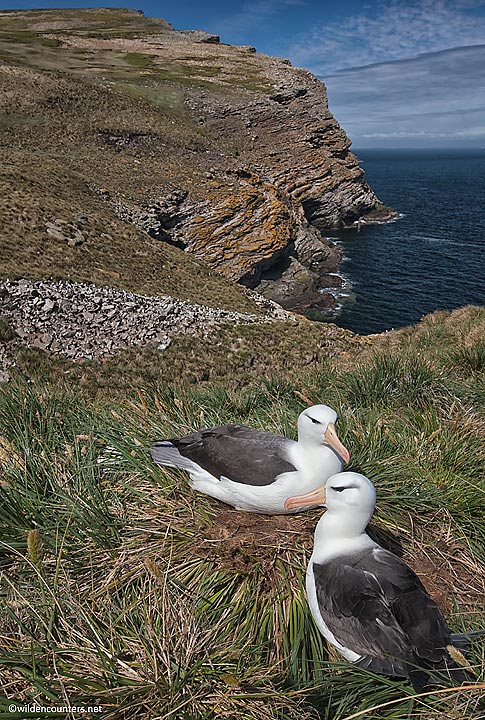
Black-Browed Albatross pair nesting on tussock grass overlooking cliffs and sea, West Point Island, Falkland Islands
After returning to the ship for lunch, we made a brief sail to Grave Cove on West Falkland Island, home to a rookery of over 6,000 Gentoo Penguins. By now the weather had returned to type – a howling gale accompanied by horizontal rain. After hiking across the peninsula, I settled down on a sodden beach as waves of Gentoo Penguins porpoised in through the crashing surf. With the rain beating down, many of my fellow travellers chose to leave their expensive camera equipment unpacked but to do so was to miss out on some truly spectacular action as these following images demonstrate. A large lens hood proved scant protection from the wind-blown rain and a shammy cloth proved an essential piece of equipment as it was necessary to wipe the lens constantly.
As I trudged back to the ship in the cold rain knowing that a hot shower awaited me, I thought about the Gentoos, fully exposed to the elements and with no hope of shelter. But of course Penguins are ideally built for these conditions with the densest feather arrangement of any bird species – around 70 per square inch, to keep them warm. Indeed, a Penguin’s biggest problem is not the cold – but rather overheating. Heat can only escape from the bare areas on their feet, the base of their bills and from the underside of their flippers.
Usually when the weather turns for the worse in these latitudes, it is here to stay for a few days but surprisingly the next day dawned fine and bright as our ship pulled into the bay adjacent to the fabled “Neck” at Saunders Island. And what a tremendous day it turned out to be! The mile long stretch of golden sand on the other side of the neck plays host to large numbers of Gentoo, Rockhopper and Magellanic Penguins. A steep trek up the overlooking cliffs finds large numbers of Imperial Shags and Black-Browed Albatrosses. In the morning, I mainly concentrated on the Gentoo Penguins in and around the surf line.
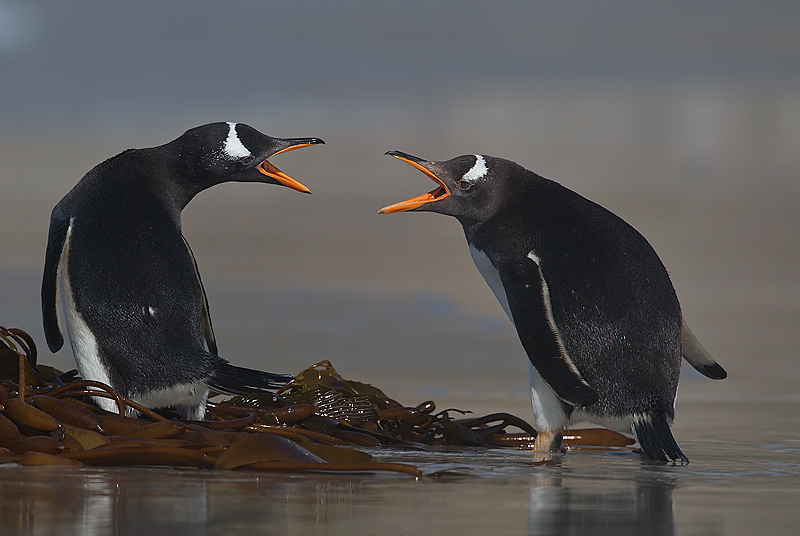
Gentoo Penguins standing over seaweed at the surf line, squabbling, Saunders Island, Falkland Islands
At midday I laboured up the hill to an area at the very edge of the cliffs. From this vantage point, a constant stream of Imperial Shags flew by at close distance, many carrying nesting material in their bills. My 70-200mm lens was easily enough focal length while a little fill flash helped to bring out the shadows on the underside of the bird’s wings.
In the afternoon I moved down to the far side of the beach to an area where numerous Rockhopper Penguins were active. I first followed them from the sea as they porpoised with great speed and agility in through the surf to the beach. Photographing this type of activity is extremely difficult as they travel with great speed underwater and usually in an erratic fashion meaning that you have to try and guess where they will surface. This is a fairly thankless task and the following image owes more to luck than anything else.
Once in the shallows, I noticed that some of the Penguins would, initially upon standing, shake their wet feathers. I aligned myself into position so that I had the dark cliff face as my background. The following image is one of my favourites from the trip.
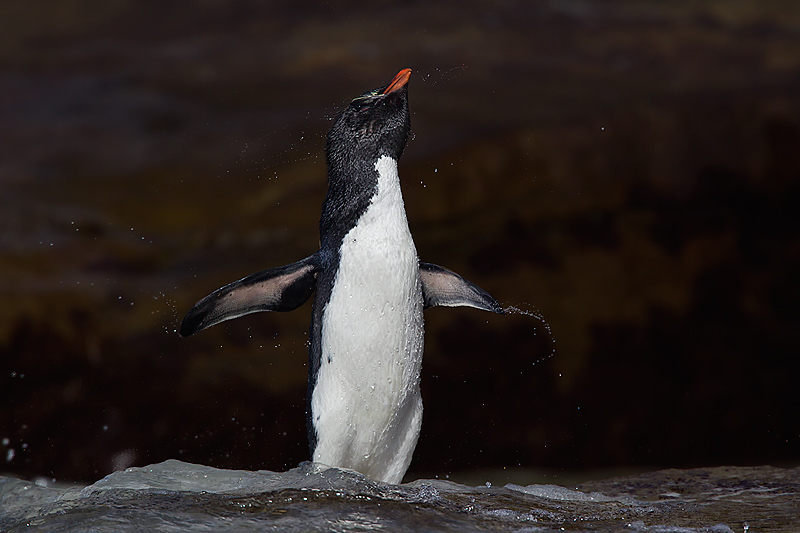
Rockhopper Penguin standing in shallow sea against dark cliff, shaking wet feathers, Saunders Island, Falkland Islands
Rockhoppers moving in the other direction – from the cliffs down to the surf – would on occasion stop to bath vigorously in a beach side rock pool.
As I was leaving the beach at the end of the day, I noticed a Striated Caracara feeding on a Gentoo Penguin carcass. Lying flat on the sand I was able to capture this moment just as the Caracara began to take flight.
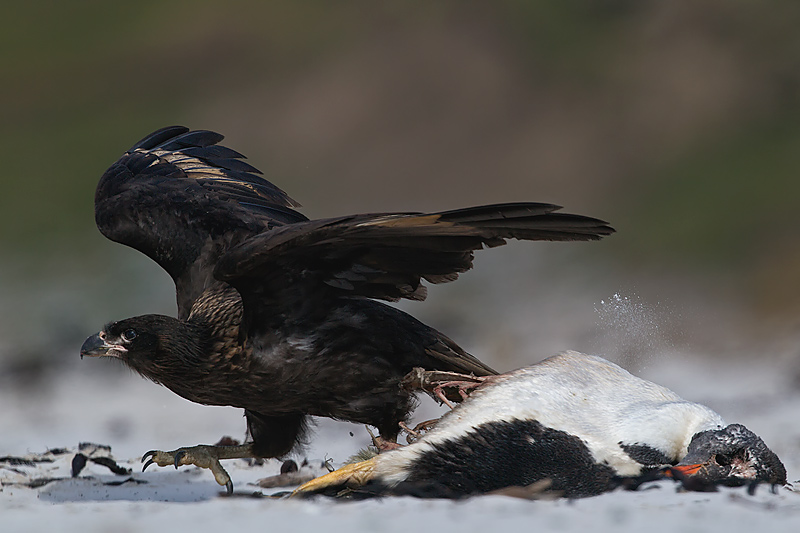
Striated Caracara with wings raised beside Gentoo Penguin carcass, Saunders Island, Falklands Islands
From the Falklands, we headed south east into the normally storm ravaged seas of the “screaming 60’s”. However, our luck continued to hold and we again enjoyed very modest sea conditions during the nearly 3-day, 900 mile crossing to South Georgia.
Arriving at Right Whale Bay on the north end of South Georgia, we were greeted by cold, rainy, low visibility weather. Somehow this seemed fitting for this remotest of wildlife outposts. With the beach landing by zodiacs taking place at 5pm, this was a brief two hour excursion and helped give us our first proper viewings of large numbers of King Penguins (a handful were visible at Saunders Island in the Falkland Islands) as well as the truly ginormous male Elephant Seals. It also gave us our first brush with the hyper aggressive male Fur Seals. Our visit coincided with the breeding season and most of the beaches in South Georgia are populated with large numbers of male and female Fur Seals. Wide in girth after a winter of ocean feeding, the males are in a state of heightened aggression and that includes their behaviour towards human interlopers. By the time we had arrived, many of the males had established breeding territories which they defend with vigour against encroaching male Seals or humans of either sex. They maintain these territories in order to have exclusive breeding access to the females that settle in them. Males that do not hold territories seldom mate. However, holding onto a territory is difficult, with only the largest and fittest fighters accomplishing the task.
Even the seasoned South Georgia visitors among the tour leaders were surprised by the extent of the aggression displayed by the males on our landings. When one charged our Scottish geologist/naturalist from a good 30-40m away, he was unprepared for the speed and the uncompromising nature of the attack. Loud barking and rock banging had zero effect and the next moment he was on his back with a considerable set of canine like teeth impaled into his right knee.
Several stitches later and doused with antibiotics, he good humouredly admitted that the worst part of the whole incident was not the pain of the inflicted wound but the reeking, fish-infused breath of the Seal in his face.
From then on, it was pretty much mandatory that one always carried a tripod to help fend off attacks and that you never turned your back for too long lest you be surprised by a sneak assault.
The next morning we awoke offshore from one of South Georgia’s landmark bays – Salisbury Plain, home to thousands of King Penguins and hundreds of Elephant Seals. Although all visitor landings on South Georgia are on the more sheltered eastern side, “sheltered” needs to be used loosely as many of the bays are wide and open and in fact offer relatively little shelter. Some of the more open bays have beaches that emerge from deep water just a few meters offshore meaning that they are subject to wave conditions on all but the calmest of days. Today was not one of those calm days. Instead there were cloudy skies, intermittent heavy rain and a strong wind.
As we boarded our zodiac for the beach we were warned that landing conditions would be “difficult”. All looked to be going well but as the zodiac reached the shore and with the outboard engine switched to idling, the zodiac turned parallel to the beach, just in time for a wave to crash over the sides. Although I was wearing thigh high neoprene waders and waterproof trousers and jacket, some of the icy water managed to penetrate to my lower back, legs and feet.
And so I sloshed onto the beach, surrounded by King Penguins and aggressive Fur Seals. Because of the latter and because of the likelihood of an early departure due to mounting winds, it was decided to limit the area in which our party could venture. As it turned out, I never ventured more than about 30m from where we landed. While the Fur Seals were a major obstacle, there was also plenty going on in our immediate vicinity to keep me occupied and I mainly focused on the King Penguins entering and exiting the surf as well as close-up, abstract images of the King Penguins’ head, neck and breast colourations.
Late in the morning, the wind suddenly began to strengthen. It quickly became clear that this was the onset of the famed katabatic winds. These are localised, hurricane force winds that blow down from South Georgia’s glaciers. Technically they are drainage winds – a wind that carries high density air from higher elevations down a slope under the force of gravity. In short, they are not to be taken lightly. Once they gain full strength, they can last for several hours making any sort of zodiac travel impossibly dangerous (i.e. the winds are of such force that they can easily flip a small boat).
Our excellent excursion leaders quickly rounded up everyone and had us all back on board our ship within 20 minutes, just before the full force of the winds began to take effect.With no let up during the afternoon, we were forced to sit it out in a nearby slightly more sheltered bay. However, late in the afternoon, while the winds remained unrelenting, the clouds parted and the effect of the wind-induced sea spray produced rainbows of varying intensity. As with all rainbow images, it is imperative to use a circular polarizer filter to bring out the true colours.
One of the things that you quickly learn in this part of the world is that the weather is incredibly changeable. And so after the sunshine of the previous afternoon, the following morning proved to be truly miserable with low cloud, heavy rain and wind. However, our chosen landing sight, Prion Island, was relatively sheltered, so zodiac landings were possible.
Prion Island contains a special protected area which is home to breeding Wandering Albatrosses, the largest of all the Albatross species. In previous years, the excursion to the Albatrosses has involved an arduous hike up a rocky stream. However, once there, it was possible to get quite close to the Albatrosses and take often dramatic wide-angle images of the birds against the ocean and distant snow covered mountains. Alas no more, as a wooden boardwalk has since been constructed and while this makes the walk to the birds much easier, the rules now state that all visitors must remain on the boardwalk.
All the birds that we encountered were some distance from the boardwalk, necessitating the use of our longest lenses. And with the pouring rain, it ended up being a visit hardly worth undertaking. Indeed to take the four images that I made that morning proved more troublesome than rewarding with my equipment receiving a thorough soaking. Fortunately today’s pro body cameras and lenses are incredibly resilient and emerged none the worse for wear.
The rain continued to fall throughout the afternoon and while there was a brief landing undertaken late in the afternoon, I elected to stay on board.
In typical South Georgia fashion, the next day dawned fine with the ship having made its way during the night to Fortuna Bay. We made our beach landing in surprisingly tranquil conditions to find decent numbers of King Penguins, Elephant Seals and the obligatory belligerent Fur Seals. However, for me the highlight was a small pool where a group of Elephant Seal youngsters were frolicking.
As midday approached, the wind again began to rise, signalling the onset of more katabatic winds. Again, there was a scramble by the expedition leaders to round up all the participants and get everyone back to the ship before the winds became unmanageable. This was duly achieved but not before the winds flipped one of the zodiacs, propelling the driver (fortunately there were no guests on board) into the icy waters where he endured an extremely uncomfortable few minutes before he was rescued.
In the afternoon, we made our way to King Edward Cove. At the landward end are the remains of the old whaling station of Grytviken and on the seaward side are the buildings of the British Antarctic Survey research base. The visit gave us a chance to undertake some non-wildlife photography among the dilapidated and rusting remains of the old whale processing machinery.
The first image shows the rusting hull of an ancient whaling ship with its harpoon gun clearly visible on the bow. To capture all the tonalities of the ship, sky, sea, mountains etc, I took five images at different exposures and blended them together using HDR software.
Hidden away amongst to rusting whale blubber vats, I discovered a pile of rusting screws. I again took multiple images at different exposures with the aim of blending them together using HDR software. However, I found that the best results were obtained using a single image but applying Nik’s total contrast filter in Colour Efex Pro 3 (note that I have used version 3. The tonal contrast is actually superior in version 3 vs the newer version 4).
The area was not completely devoid of wildlife and as the sun began to set, I found a small group of King Penguins in a pond created by a glacier melt water. The light was fantastic – the only time on the whole trip that we had really sweet light with wildlife photographic opportunities – allowing me to focus on the beautiful colours of the Penguins’ heads and necks. The first image shows one of my favourite techniques, which is to juxtapose two animals of the same species against each other – typically one in focus, one out of focus.
At the exact moment that I pressed the shutter for the next image, a moment of serendipity occurred when one of my fellow passengers, wearing an orange jacket passed by opposite to where I was positioned. The reflection of his jacket on the deep blue water resulted in an orange tinge to the water which in my view really helps to make the image.
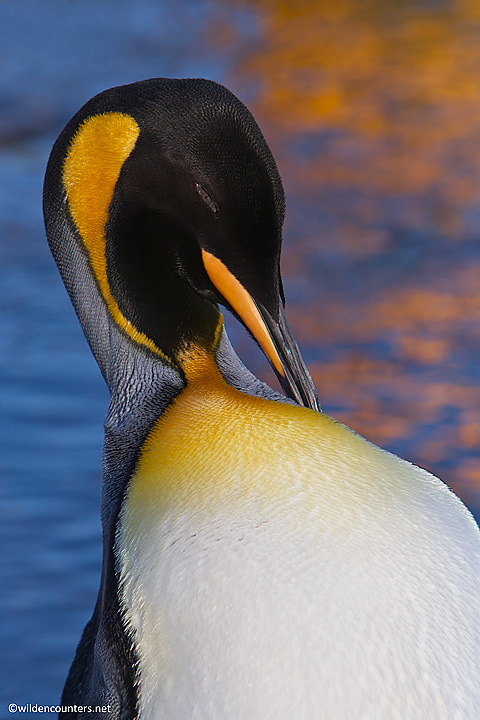
King Penguin preening in late afternoon light with blue and orange backgound coloured water, Grytviken, South Georgia
November 18th. Three words – oh my god. For years I had dreamed of visiting St.Andrews Bay, the undisputed wildlife Mecca of the sub-Antarctic region. I finally got my wish and with the weather gods on our side we were able to spend a full day at this truly remarkable site. As a wildlife spectacle, it has to be way, way up there with anything the entire natural world has to offer. From my own personal experience, it probably exceeded the Emperor Penguin rookery at Snow Hill in the Weddell Sea and I would say that only the Grouper aggregation and spawning in French Polynesia that I have witnessed in two of the last three years betters it.
St.Andrews Bay is the largest King Penguin rookery in South Georgia. There are 60,000 pairs of birds and when the “woolly” chicks are included, the total number of birds rises to 160,000, although at any one time some of course will be at sea. The shore line is thick with Elephant Seals which blanket the beach in such dense numbers as to make passage through them difficult.
Chick rearing for the King Penguins takes longer than for any other Penguin species with about 14 months between egg-laying and the chick becoming independent. As a result a breeding pair can raise a maximum of two chicks in three years. This unusual cycle means that, unlike other Penguins, a colony of Kings is not synchronised in its breeding. Hence on our visit, there were some Penguins incubating, some brooding small chicks and others with very large chicks nearing fledging.
As a photographer, it is very easy to be overwhelmed by St. Andrews Bay. While common sense dictates that the best images will come from slowing down and remaining for long periods in a few chosen spots, the temptation to rush around and try to capture as much as possible of the Bay’s broad expanse is almost impossible to resist unless one has visited the site a number of times before or one can somehow remain extremely disciplined.
Not me I’m afraid, so off I charged. And charge and charge I did for the next ten hours. I covered a lot of ground when in hindsight I would have been better off just remaining in 3-4 places. I took a lot of slow shutter speed images but even with the camera fully locked up, the lens hood removed, mirror lock activated, and IS turned off, the strength of the wind made it extremely difficult to avoid camera shake, resulting in nearly all the images going straight to delete. I made many other mistakes. I missed many opportunities. But I still made out OK and I will surely do much better when I next return.
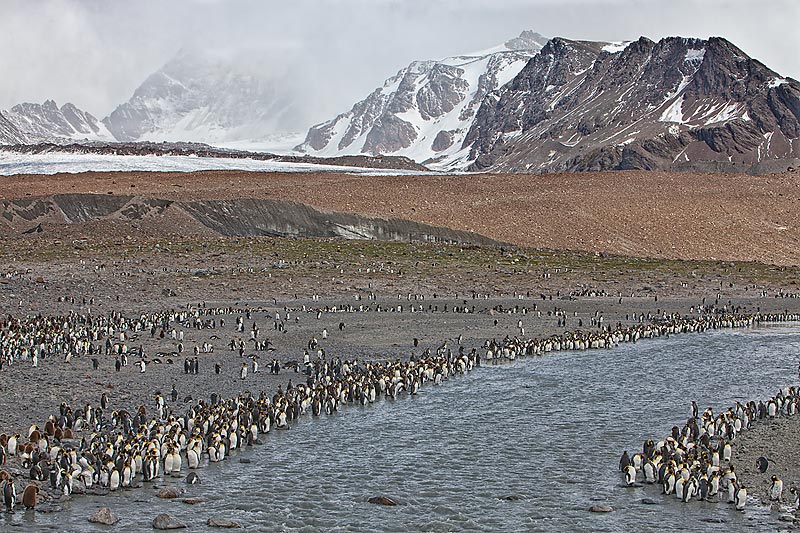
King Penguins and chicks gathered along the banks of a glacier melt river, St Andrews Bay, South Georgia
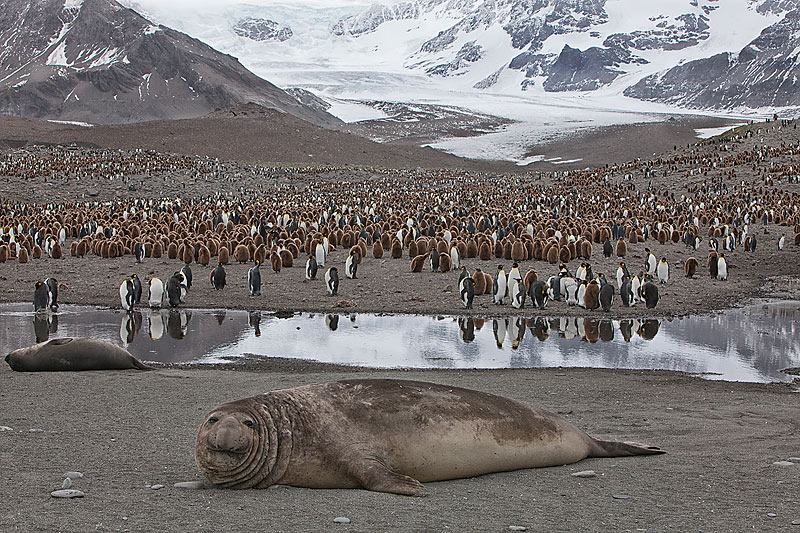
Elephant Seal in front of King Penguin colony with glacier and snow-covered mountians in the background, St Andrews Bay, South Georgia
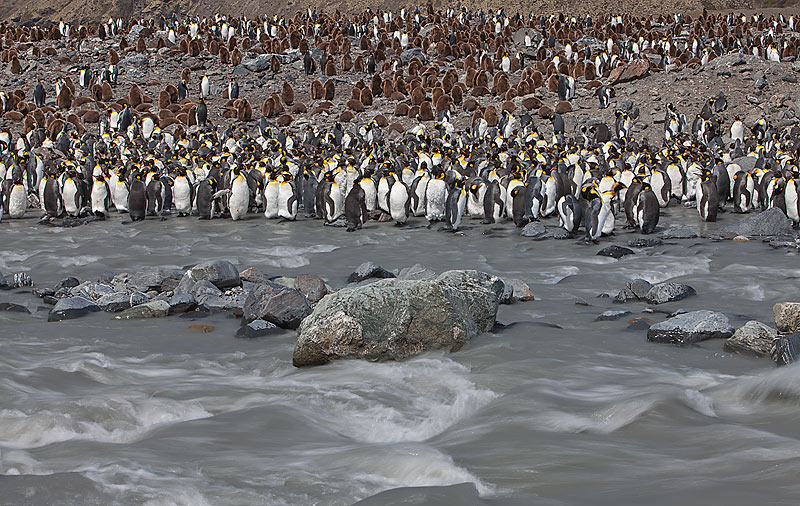
King Penguins and chicks grouped along the edge of a glacier melt river, with motion, St Andrews Bay, South Georgia
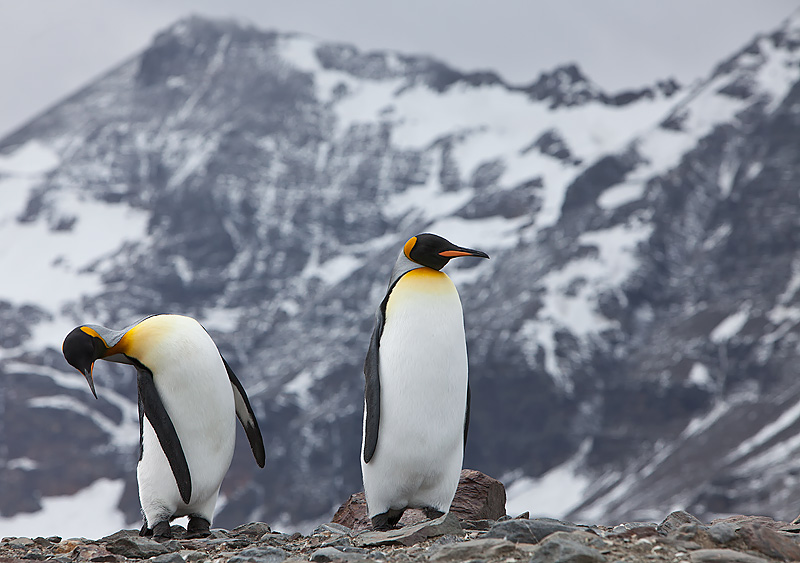
Two King Penguins standing against a backdrop of snow covered mountains, St Andrews Bay, South Georgia
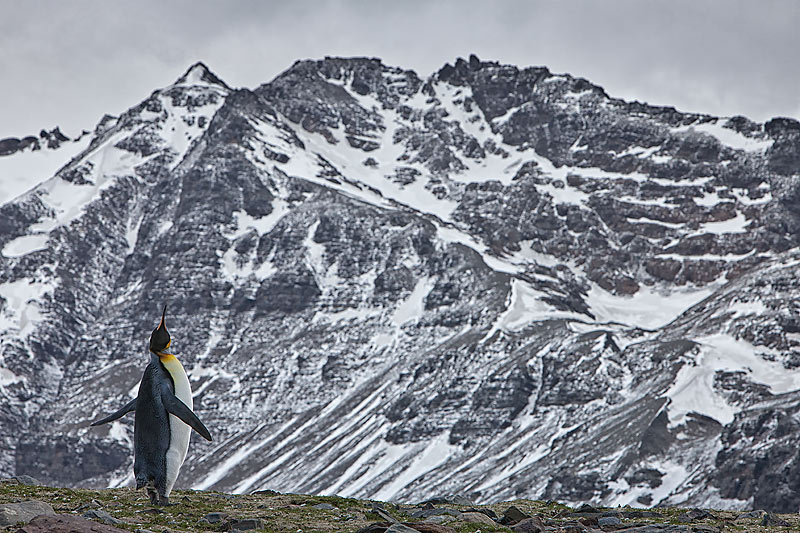
- King Penguin with raised head against backdrop of snow covered mountains, St Andrews Bay, South Georgia
The next morning dawned fine as we found ourselves in Royal Bay, a four mile wide, five mile deep bay. At the head of the bay lies the spectacular Ross Glacier. We were able to take zodiac rides to photograph the glacier and the Salvesen and Allardyce mountain ranges which ring the bay.
During lunch we continued our journey south down the east coast of the island, pulling into Cooper Bay in the afternoon. Here we again undertook zodiac excursions, this time to photograph a colony of Macaroni Penguins. During the cruise, a Leopard Seal appeared regularly in close proximity to the zodiacs. A few of the zodiacs had the good fortune of seeing this apex Antarctic predator with a recent Penguin kill in its jaws.
Our final day in South Georgia saw us pull into the picturesque Drygalski Fjord at the south-eastern end of South Georgia, flanked by the jagged peaks of the Salvesen Range. The plan had been to explore the Fjord by ship and possibly undertake some zodiac cruises but the latter activity was quickly ruled out as a new round of katabatic winds descended on the fjord. I have lived through some pretty powerful typhoons in Hong Kong over the last 40 years but I can honestly say that these winds matched or even exceeded the most powerful winds that I have experienced via cyclonic activity. In fact it was not surprising when an announcement was made over the ship’s intercom system that no-one was to venture outside onto the outer decks under any circumstances due to the genuine risk of being blown overboard. The following image was taken from the ship’s bridge.
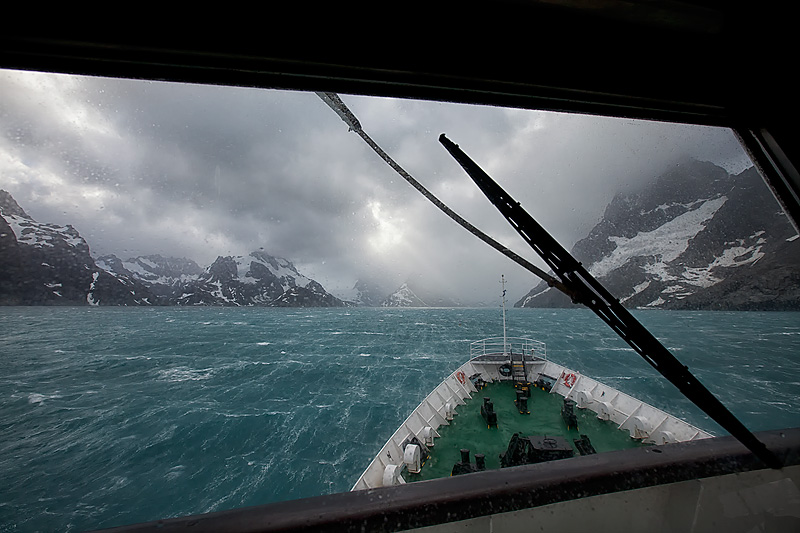
The Drygalsky Fjord, South Georgia, being subjected to hurricane force winds as seen from the bridge of the passenger ship, Ushuaiha
By early evening the winds had dropped a little, allowing some of us to tentatively venture out onto the few sheltered areas of the decks. By now the skies had largely cleared and as the sun set, spectacular pink and orange clouds floated atop the mountain peaks. A little later, beautiful lenticular clouds formed on the other side of the fjord.
At midnight, we set sail for the South Orkney Islands, en route to the Antarctic Peninsula. Again, we enjoyed good fortune with the weather during the two day crossing of the Scotia Sea. The ship continued to be trailed by a variety of sea birds. This image shows an Antarctic petrel gliding among the wave crest spray. Unlike Albatrosses and the larger Petrel species, the smaller Petrels fly in extremely erratic patterns making them a challenge to photograph.
On the afternoon of the second day we began to see our first icebergs. The South Orkneys lie in the path of the Weddell Sea gyre which sweeps vast quantities of ice past the islands into the Southern Ocean. It is hard not to be moved by the beauty of the icebergs, ice floes, ice sheets and ice shelves. I know that I could spend all day photographing them. Icebergs in particular are so incredibly diverse in size, shape and colour that I never get tired of them.
The South Orkneys are home to some of the continent’s most impressive icebergs, with the added attraction that many play host to Chinstrap, Adelie and Gentoo Penguins. The aim this afternoon was for the ship to cruise by some of these icebergs, reducing speed if necessary, in order for us to photograph them.
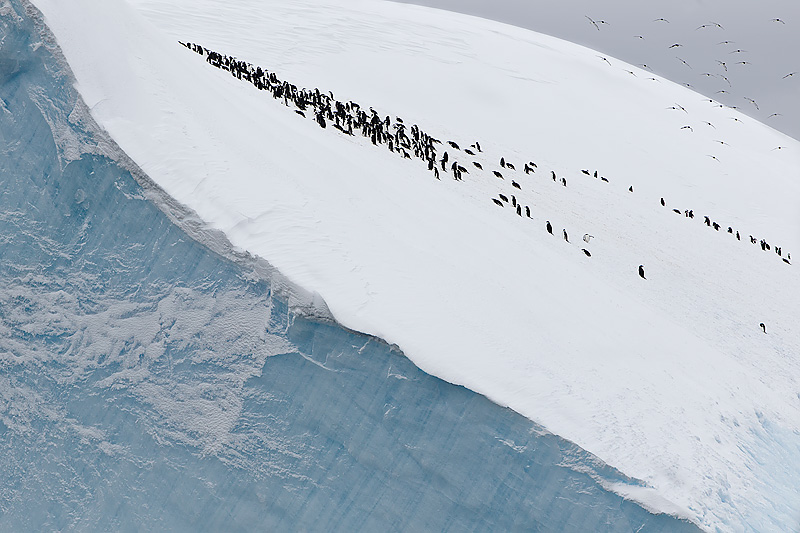
Chinstrap Penguins on sloping iceberg face with Cape Petrels in the sky, South Orkney Islands, Southern Ocean
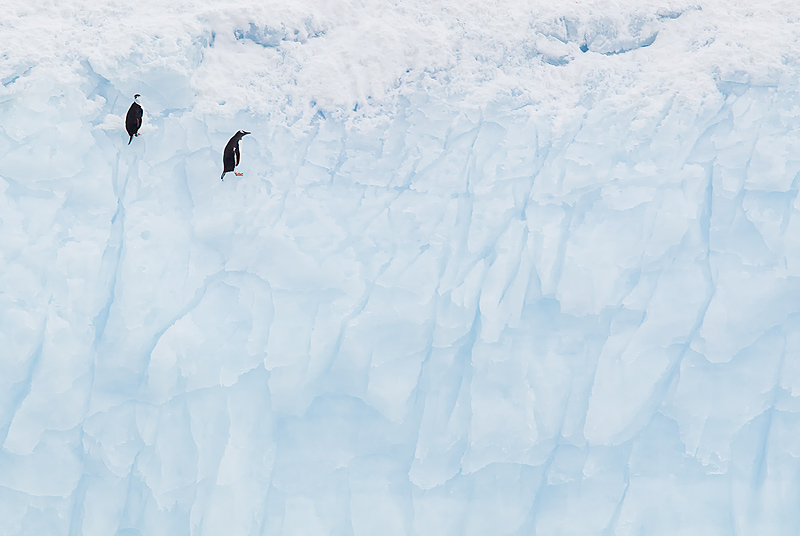
- Chinstrap and Adelie Penguin standing on near vertical iceberg face, South Orkney Islands, Southern Ocean
You will note that sometimes the icebergs have distinct patches of blue/turquoise coloured ice. Ice itself is actually blue but it will seldom look that way unless you are looking at a large piece of glacier ice. Our eyes are not particularly sensitive and we need a large chunk of ice to reflect back enough blue light for us to recognise it as blue. Glacial ice is usually big enough. Small pieces of ice are not. Some large icebergs look white and that is because we are seeing more than just ice; we are also seeing air bubbles. When light shines through ice that has a lot of air in it, the ice reflects back all the colours of the spectrum which we perceive as white. In the presence of a lot of ice reflecting its true blue and a little bit of air reflecting its true white, the white prevails. The bluest ice often comes from the bottom of the glacier because that is where the oldest ice sits. The older the ice, the greater the pressure and the fewer the air bubbles.
The next morning we arrived at the north end of Antarctic Peninsula. Turning south east, we sailed through the Antarctic sound. Ice build-up prevented our scheduled shore landings but it was still a thrill to cruise through the myriad of often epic proportioned icebergs. In the early afternoon, we were able to sail through a large area of pancake ice. Later, we had a chance for some zodiac cruising among the icebergs. When we chanced upon a small but deep blue ice hole at the bottom of one of the icebergs, nature photographic luminary, Joe Macdonald, who was guiding our zodiac, mentioned that he wished he had a fish-eye lens. I had totally forgotten that I was carrying one, buried within an inside pocket of my thick, down jacket. Attaching it to my camera, I lowered the camera and lens into the hole and shooting blindly (the hole was almost at the water’s edge), I fired off several images. After downloading, I was delighted with this uncropped image. I had no idea there was an opening at the other end; or that the opening would reveal both blue sky and white ice.
The following day saw us anchored next to the tell-tale conical shape of volcanic Paulet Island in the northern Weddell Sea. However, the island’s geology are of minor interest to visitors when the scale of the enormous Adelie Penguin rookery is appreciated with more than 100,000 pairs nesting here.
In the afternoon we headed to Brown Bluff, our first landing on continental Antarctic itself. Here against dramatic, 800m high, lichen-covered cliffs, we were able to photograph Gentoo and Adelie Penguins making their way onto the beach with many pausing to stop on the ice floes that lay just offshore. I also took this interesting image of a Kelp Gull peering out from behind a rock with the attractively coloured cliffs forming the blurred background. Kelp Gulls are one of the most widespread gulls worldwide but are the only species of gull that occur in Antarctica. Common they maybe, but it’s hard to ignore the beautiful colouration on their bills and I for one never tire of photographing them.
In the evening, after the sun had set and the sky had taken on a slight pink hue, I spent more than an hour in the bitter cold on deck photographing the numerous icebergs that the ship passed as we sailed towards our next destination. While concentrating on the patterns on one of the icebergs, I was fortunate when this Kelp Gull came into land.
Overnight we left the Antarctic Sound and travelled south from the Bransfield Strait into Croker Passage and the Gerlache Strait. Our morning destination was Hydrurga Rocks, a small island group with a Chinstrap Penguin colony. Landing on the narrow beach under a leaden sky, we encountered deep snow drifts which restricted our movements to a relatively small area. In the end I settled down in one spot where Chinstrap Penguins were periodically traversing a snow covered slope. From the same vantage point I was able to capture this image of two Kelp Gulls, nicely offset by the sloping snow field in the background.
As I photographed, I was regularly surrounded by one or two Snowy Sheathbills. Shy is not a word associated with these birds, whose rapid movements on foot are reminiscent of Pigeons, and they regularly approached within a few feet of me. They are a pretty bird as this portrait indicates.
In the afternoon we undertook a landing on the northern shore of dome-shaped Cuverville Island which supports a large colony of Gentoo Penguins. Our zodiacs had to negotiate through a thick covering of brash and growler ice (the latter being the name for ice less than 1m in height). My first thought on landing was to wade into this ice (up to my upper thighs) to take some images of the ice in the foreground and the Penguin colony and snow covered mountains in the background. Like so many icescapes where the colours are already largely monochromatic, such images typically work better in a black & white format.
October and November is the mating season for Adelie, Gentoo and Chinstrap Penguins, and I was again lucky to be in the right place for this copulating pair of Gentoos. This was very much a “grab” shot as I literally saw something out of the corner of my eye, swung the camera around and fired off several shots without changing any settings. The whole event lasted no more than ten seconds. In the flat, unchanging light, having the camera set up in manual exposure and already set up for the whites of the Penguin, ensured pretty much a perfect exposure – i.e. the whites pushed well into the fifth box on the right of the histogram. I find myself working in manual more and more although for all those that think that manual mode is the answer for all situations – it is not (don’t get me started on this one).
Our journey continued south with the ship reaching the entrance of the famed, Lemaire Channel by mid-morning the next day. This narrow channel is seven miles long running along a fault line between precipitous peaks rising 3,000ft from the water’s edge. On one side lies the Antarctic continent, on the other, Booth Island. Although we were able to traverse some of the way down the channel, we found our passage ultimately blocked by pack ice, forcing us to turn around. Still, the spectacular peaks begged to be photographed, captured again in black & white.
The Lemaire channel proved to be the southernmost point of our expedition and we now headed in a northerly direction towards our next destination, Paradise Harbour. With a name like Paradise, a place has to be really spectacular to meet expectations. Paradise Harbour manages this feat even on a cloudy day. When the sun is shining, as it was upon our arrival, it is absolutely gorgeous.
Lying between the Antarctic mainland and Bryde and Lemaire Islands, the bay was named by early twentieth-century whalers who were not immune to its charms. Whales continue to visit and we managed several fleeting glimpses of both Minke and Orca Whales.
Landing at a spot occupied by an abandoned Argentinian research station, I quickly made my way up a nearby hill. The upper reaches of this hill felt more like the summit ridge of a major Himalayan peak as I broke trail with deep snow and overhanging cornices on both sides. Bathed in sweat, I finally reached the “summit” to be greeted by breathtaking views of the bay. Both of the following images are hand-held, five-frame stitched panoramas captured at 35mm.
Later I was able to take a zodiac cruise around the bay with just one other person. It really is an amazing experience to get right up close to the icebergs. The use of either polarised sunglasses or a circular polariser attached to one’s camera lens makes it possible to see the extent to which the icebergs extend beneath the surface as well as the astonishing clarity of the turquoise colours.
We also came across an incredible small black/grey iceberg with out-of-this-world, golf ball like patterns. This image shows these patterns underneath the water.
This next image is a bit more “artsy”. The base image comprises the reflections of a lichen covered cliff face in the water. Post processing, the saturation, contrast and structure have been pumped up to produce this Monet like image.
In the evening as we sailed out of the bay, bathed in soft, yellowish light, I spent a good hour alone at the very front of the ship making images of the brash ice in the now dark waters in the foreground and the snowy mountains in the distance.
We were now beginning our journey home. Sailing north overnight, we had time for one more landing, this time at Half Moon Island in the South Shetland Islands. This picturesque spot is home to a colony of Chinstrap Penguins as well as breeding Kelp Gulls and Antarctic Terns. I spent most of the morning in two locations, primarily photographing the Chinstrap Penguins as they laboured up a snow covered slope towards their rookery after returning from fishing trips out at sea. The main attraction for me was to include the beautiful lichen and moss-covered cliffs in the images.
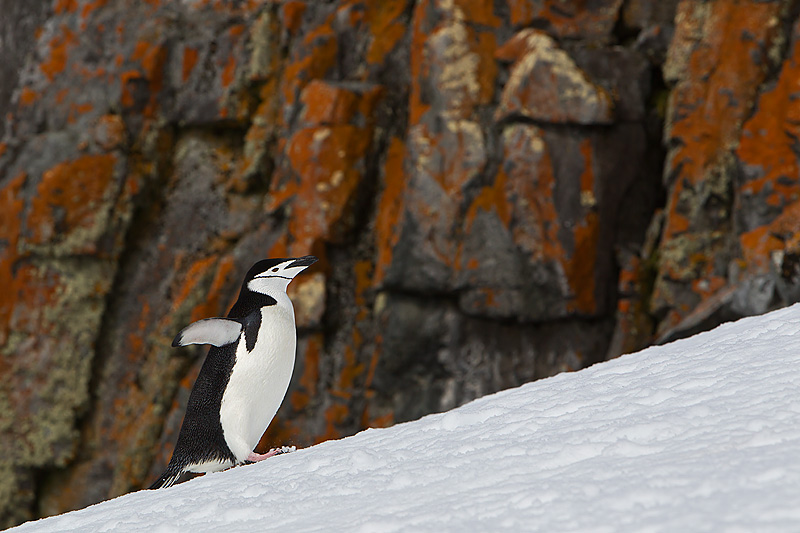
Chinstrap Penguin walking up snow slope against lichen covered cliff face, Half Moon Island, South Shetland Islands
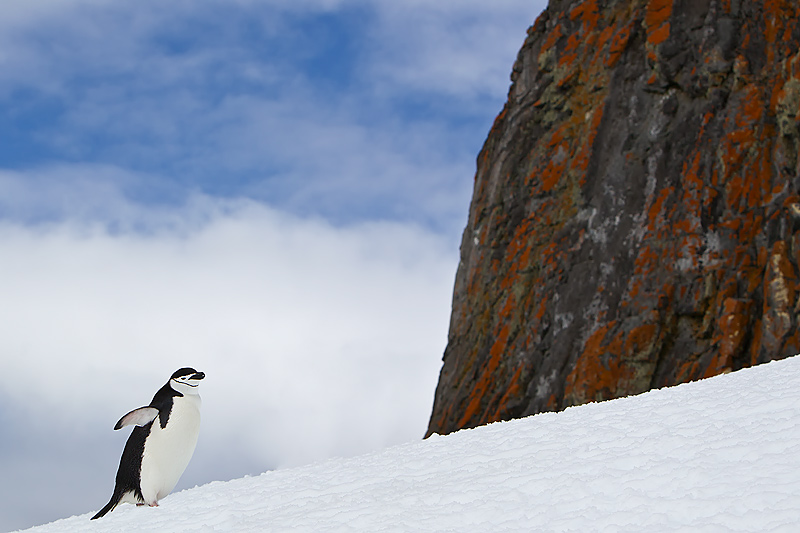
Chinstrap Penguin walking up snow slope with lichen covered cliff face at front, Half Moon Island, South Shetland Islands
I also spent time photographing the Kelp Gulls (now something of an addition) as well as these squabbling Antarctic Terns.
And so we bade a sad farewell to the land of snow and ice and its treasure trove of wildlife. As on all my trips, I kept no journal or diary (perhaps I should) but find that I can relive and recall the various locations and experiences that I enjoyed through the images that I make. We had hoped for one more landing but our trusty captain, eager to beat an impending storm had us depart for the notorious Drake Passage, slightly earlier than scheduled. For the first 24 hours sea conditions remained reasonable but then deteriorated steadily as we felt the full force of the oncoming storm. In the 9m swells, waves crashed over the ship’s bow with the spray lashing the bridge and the ship pitched and rolled violently at times.
Fortunately the captain’s foresight spared us a prolonged battering and within 12 hours we had reached the shelter of the Beagle Channel from where we made our way the next morning to the port of Ushuaia.
All in all it had been an amazing expedition, but one which has again whetted my appetite for more. Already I have plans to return, this time with a focus on the Falkland Islands and South Georgia which for me were the two highlights of the trip. A big word of thanks should go the expedition leaders, many of whom are nature photographers of international repute but who always put the considerations of the passengers before theirs and more often than not sacrificed their own image taking to tend to the needs of the expeditioners. Lastly, I would like to extend a big greeting to my new Mexican and Spanish friends from the trip, many of whom are highly talented photographers. On this note, I would like to mention a young Spanish photographer and videographer, writer and conservationist, Jaime Rojo. Not only did his images from the trip outshine those of his fellow passengers, but he also eclipsed those from the seasoned professionals on board. Remember his name as you will surely be hearing more from him in the future.
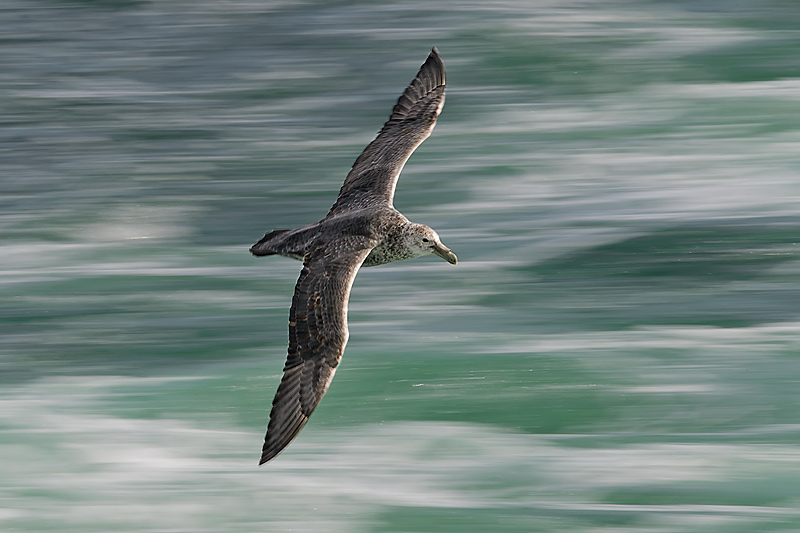
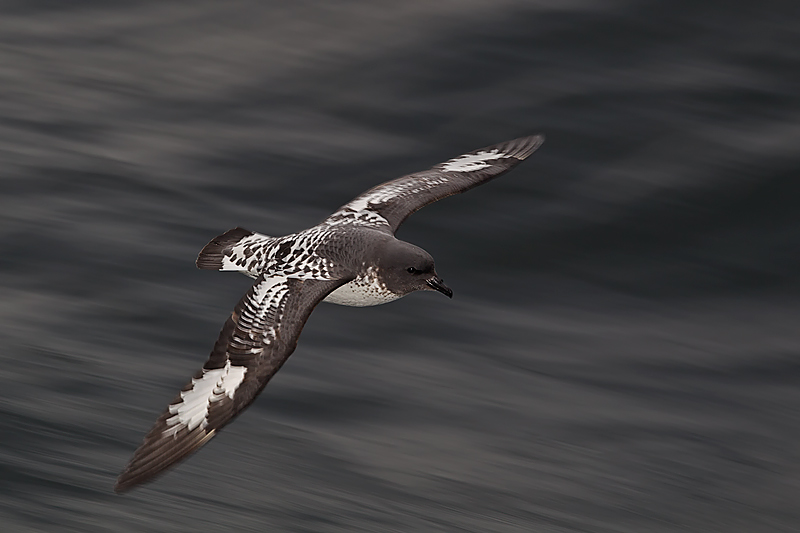
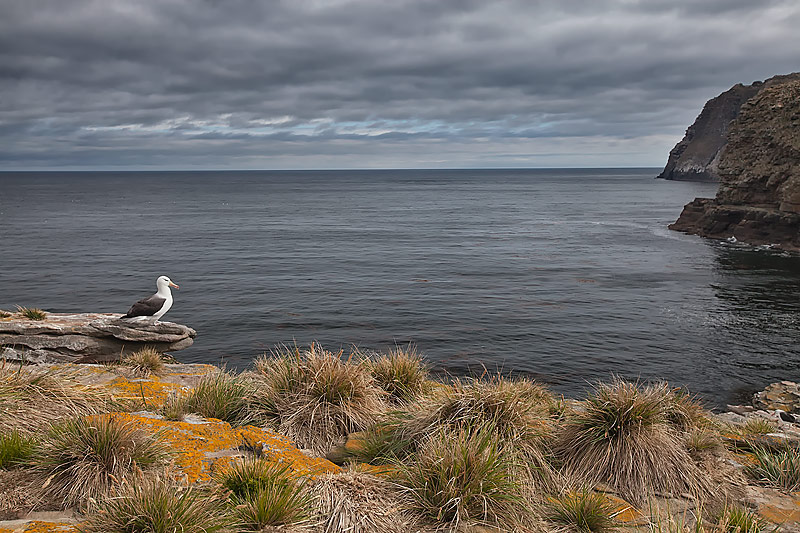
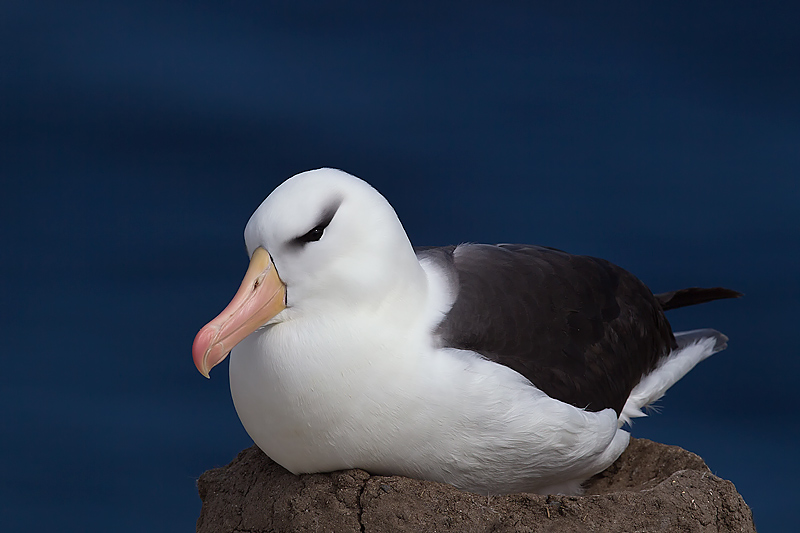
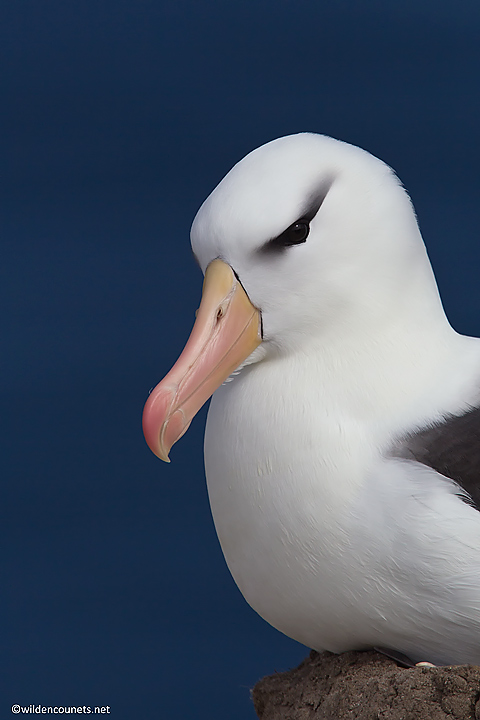
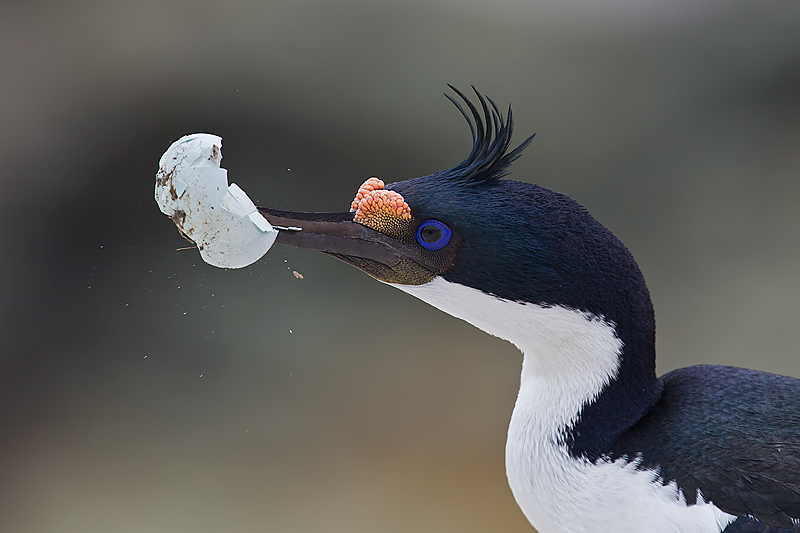
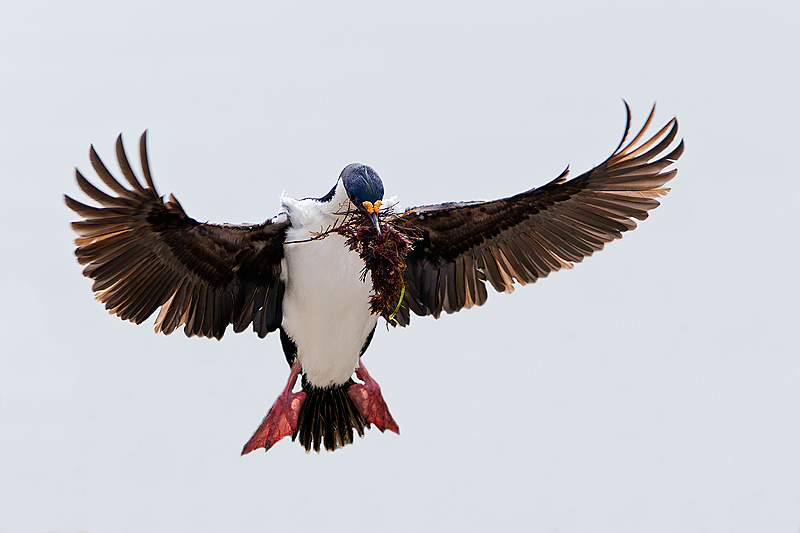
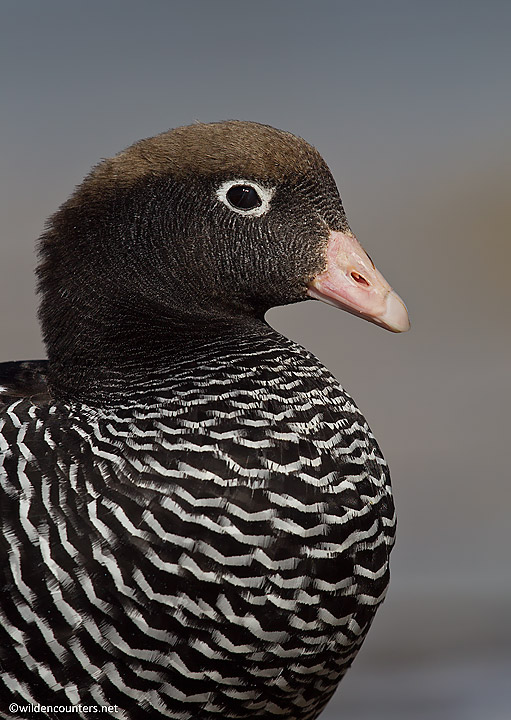
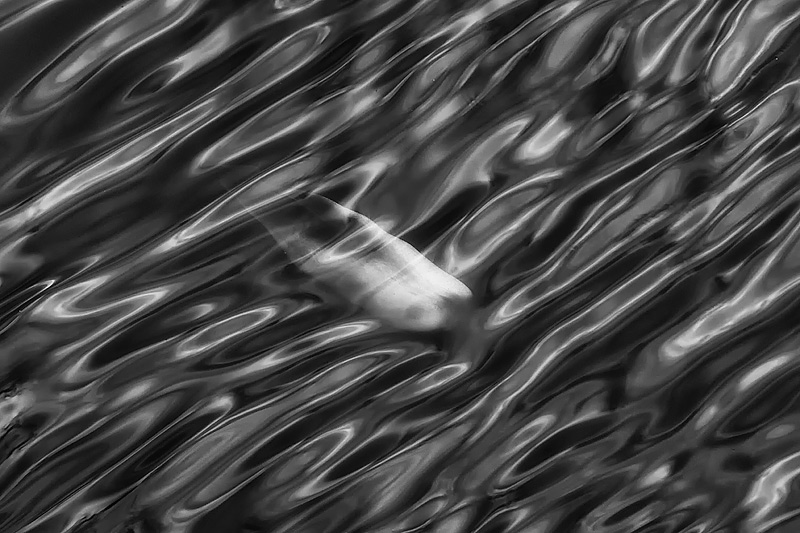
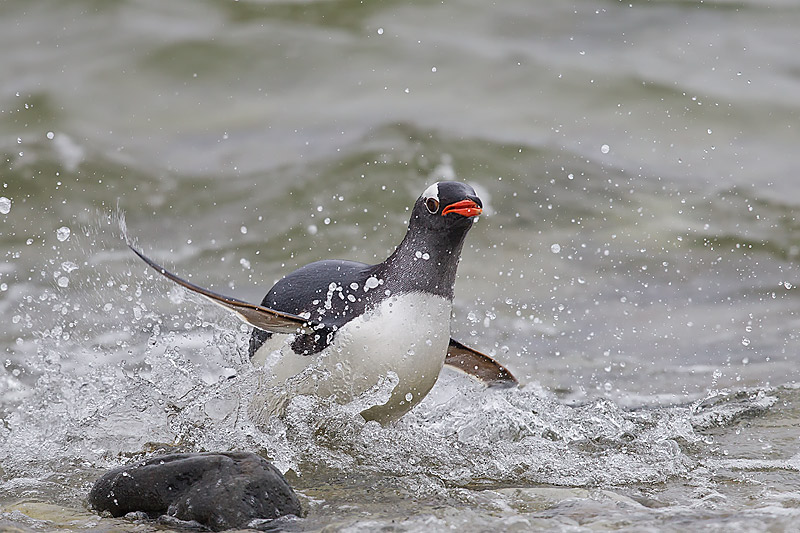
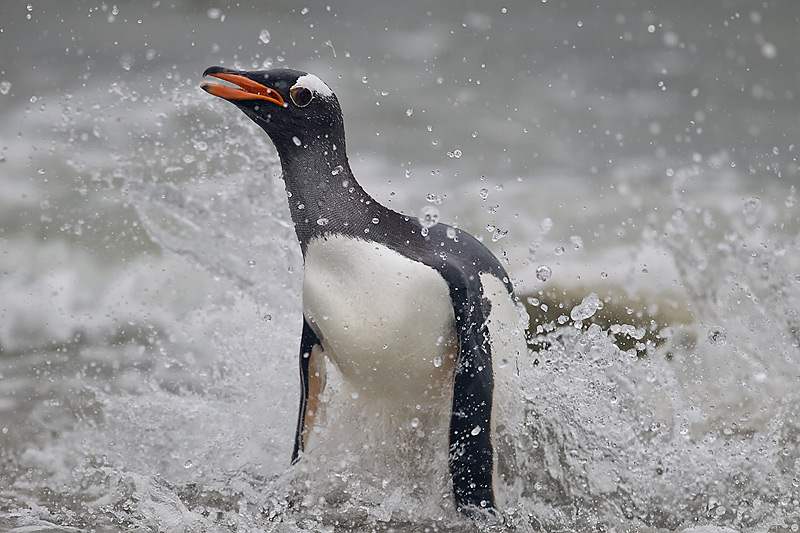
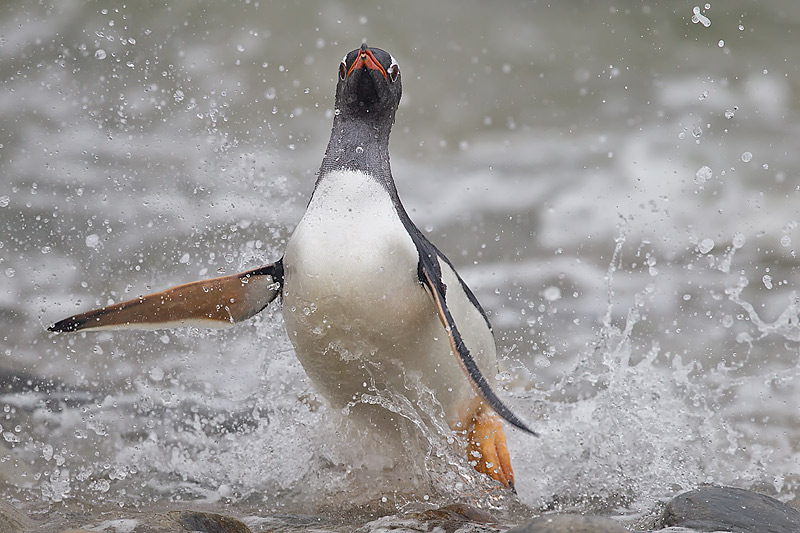
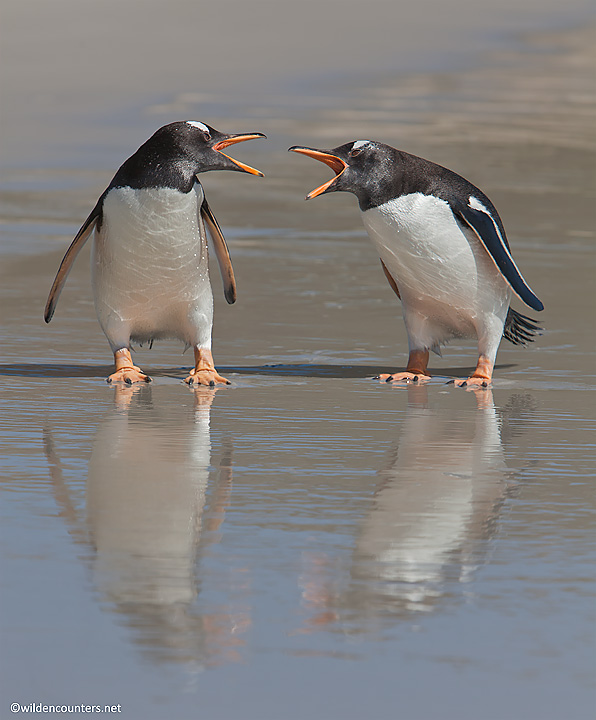
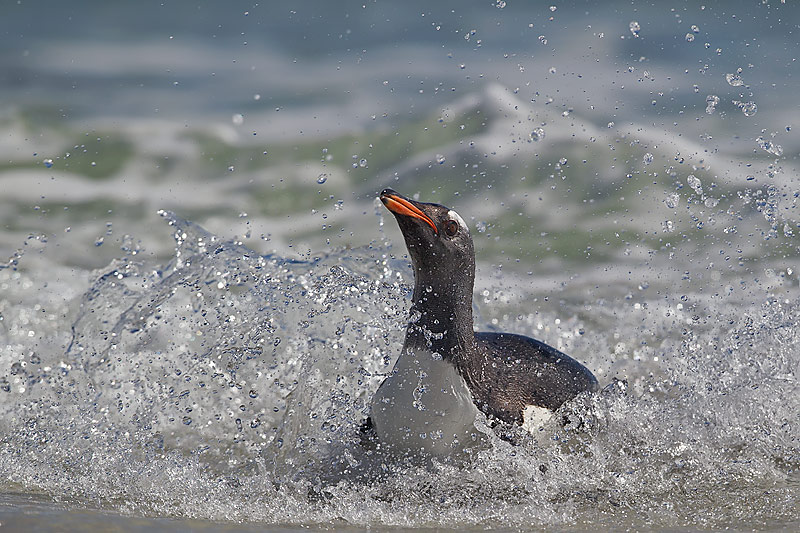
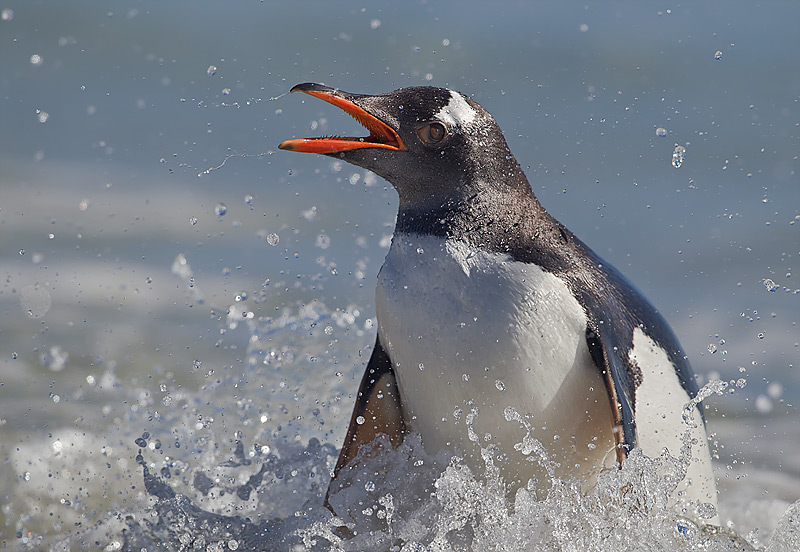
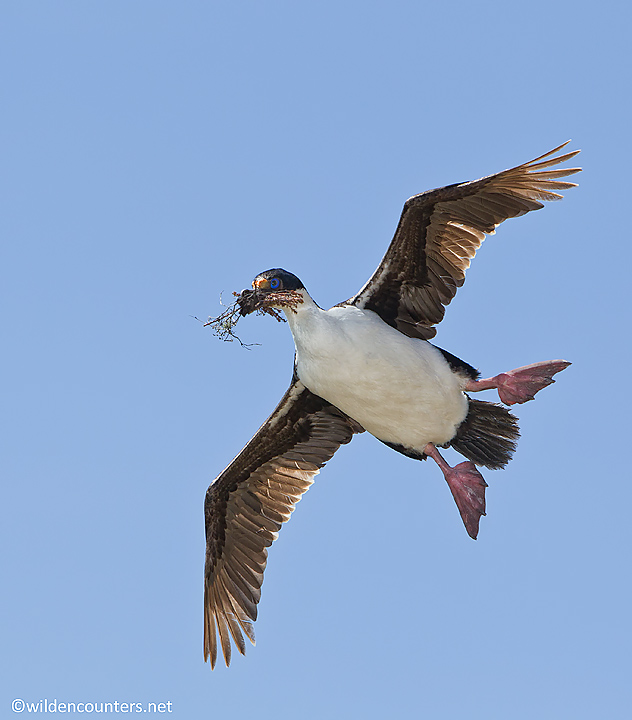
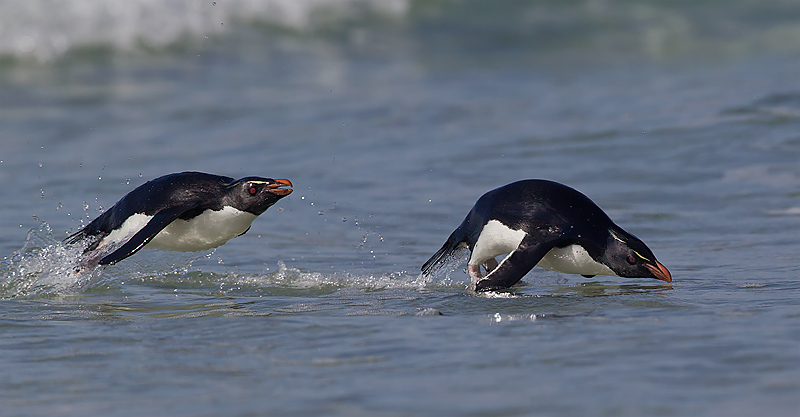
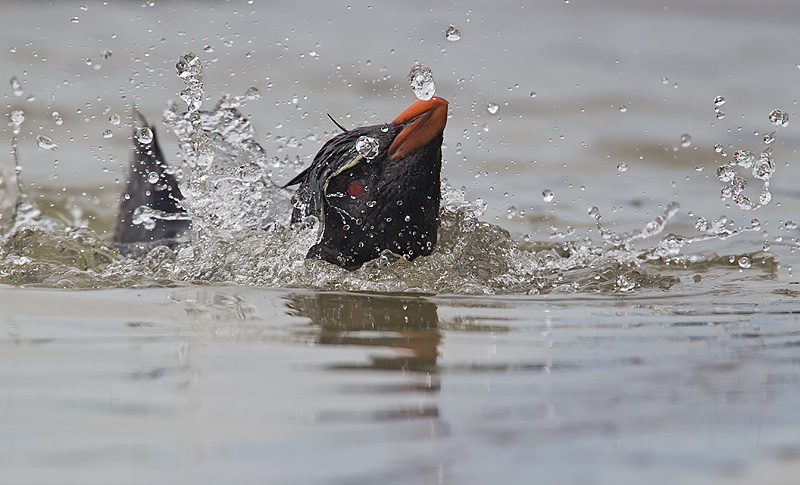
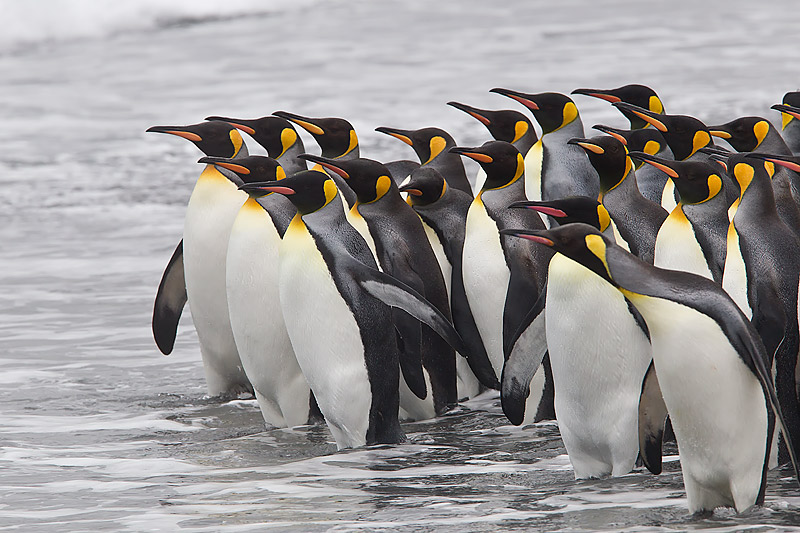
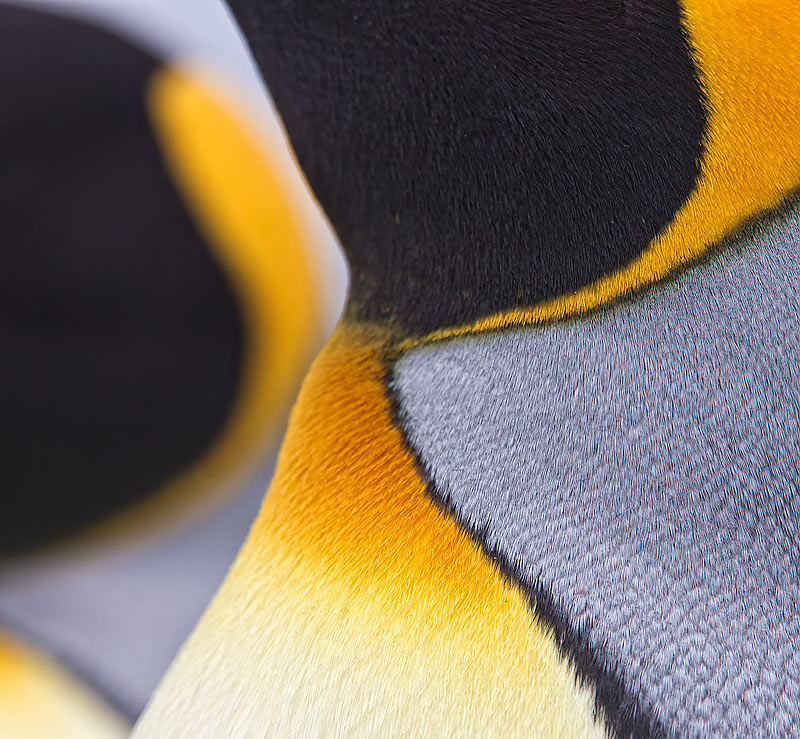
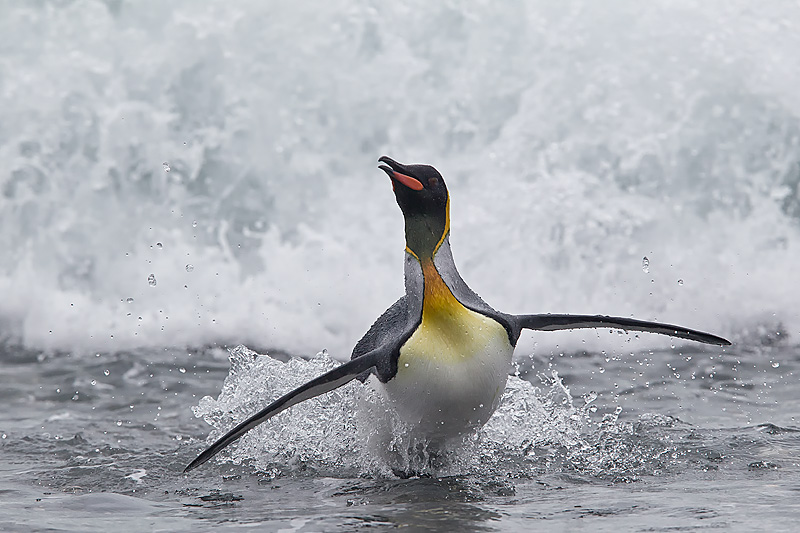
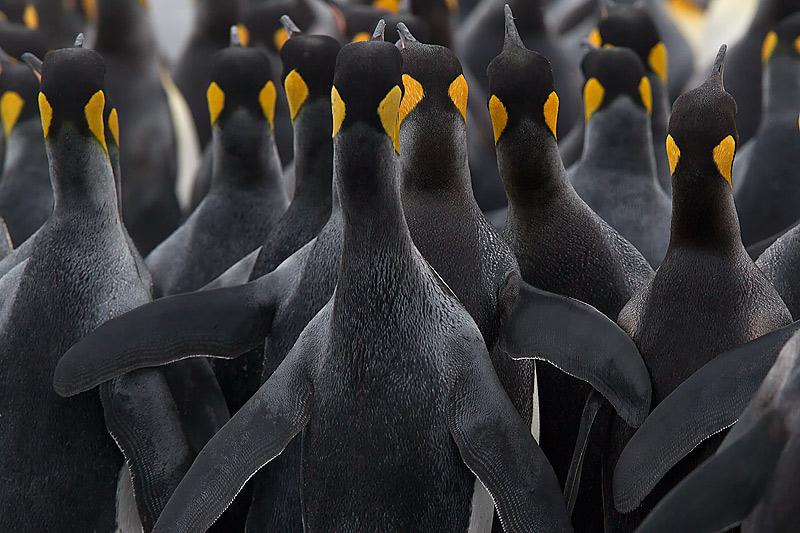
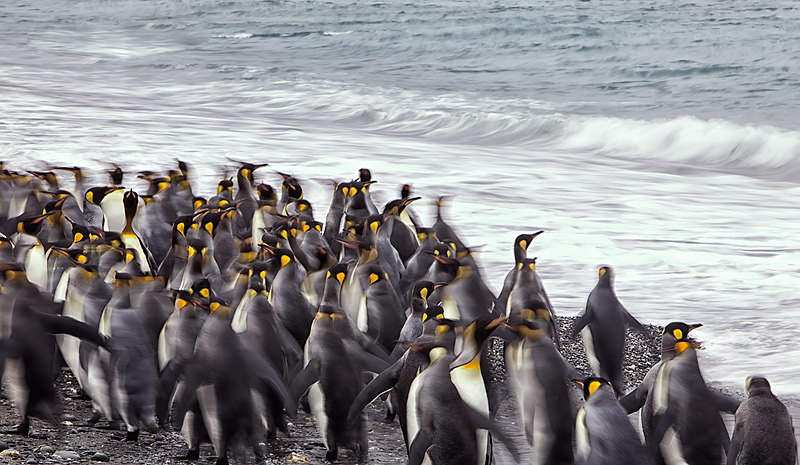
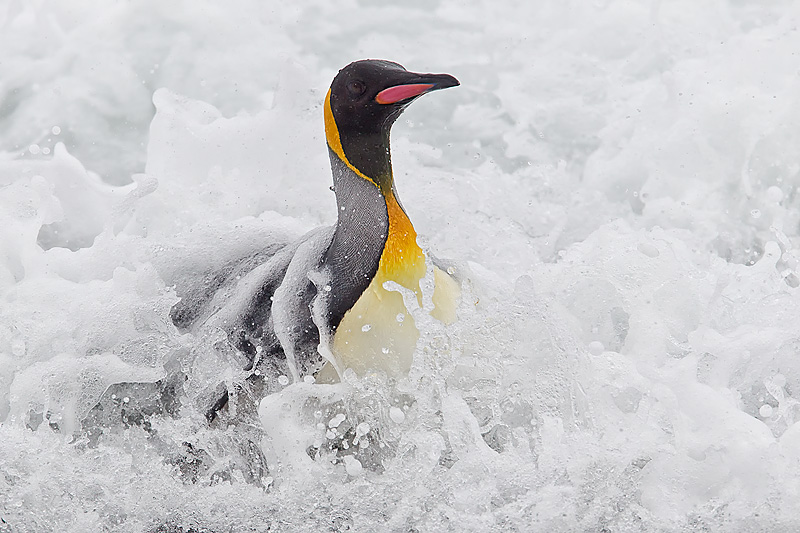
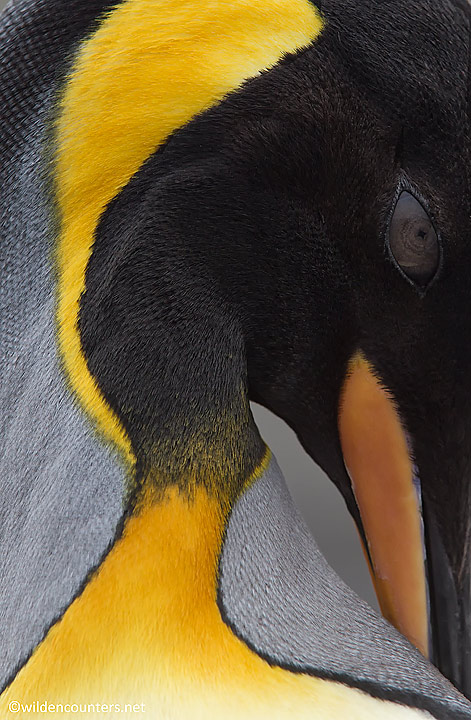
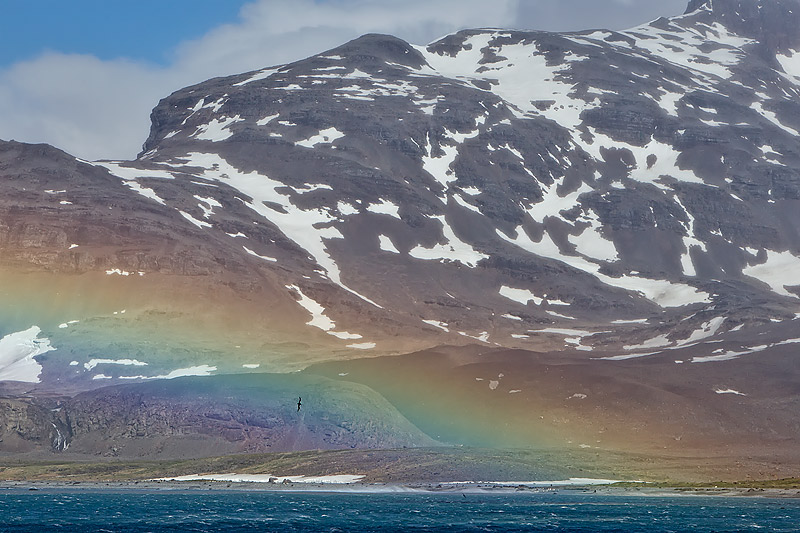
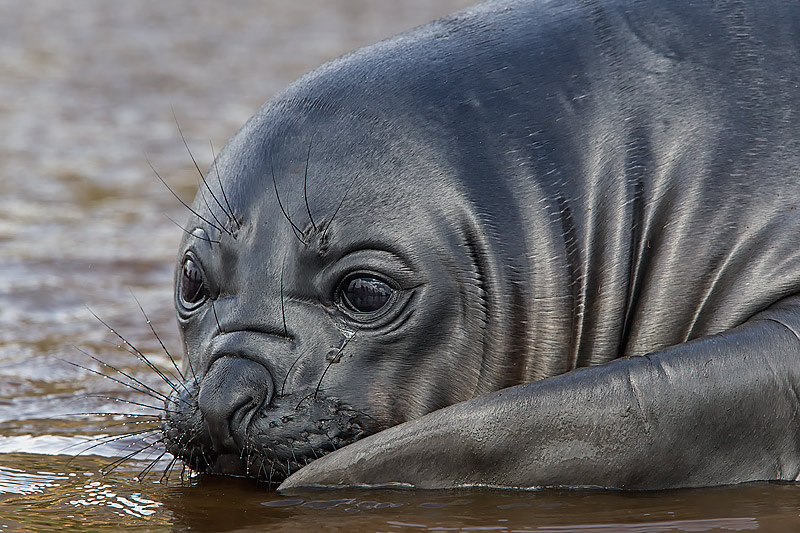
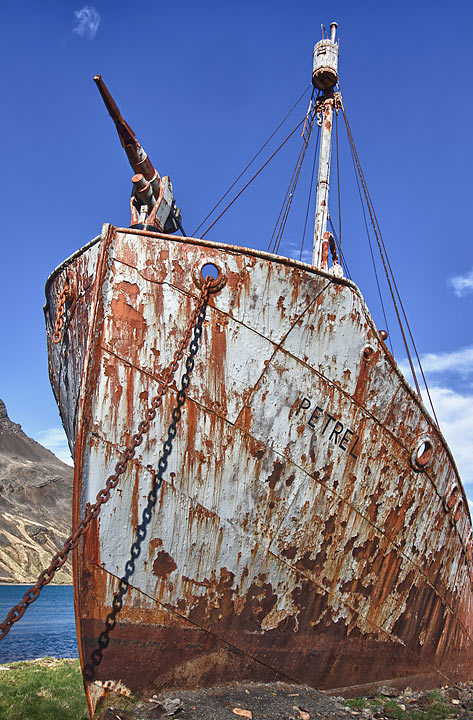
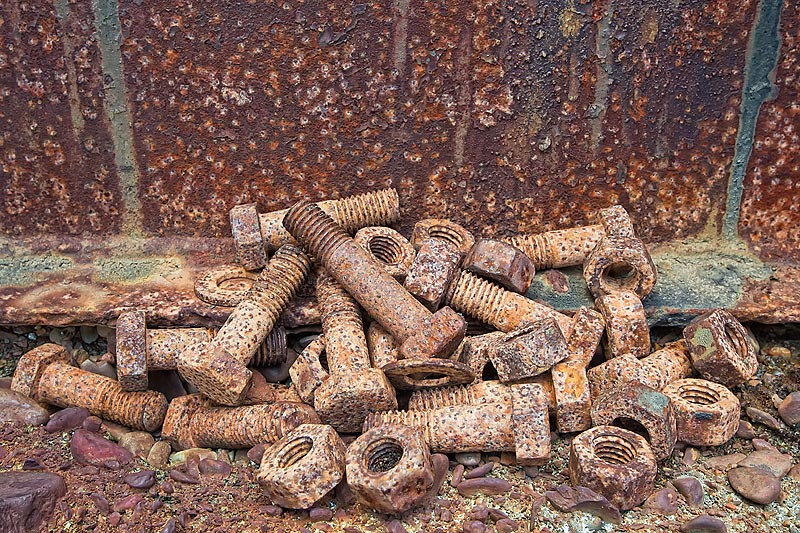
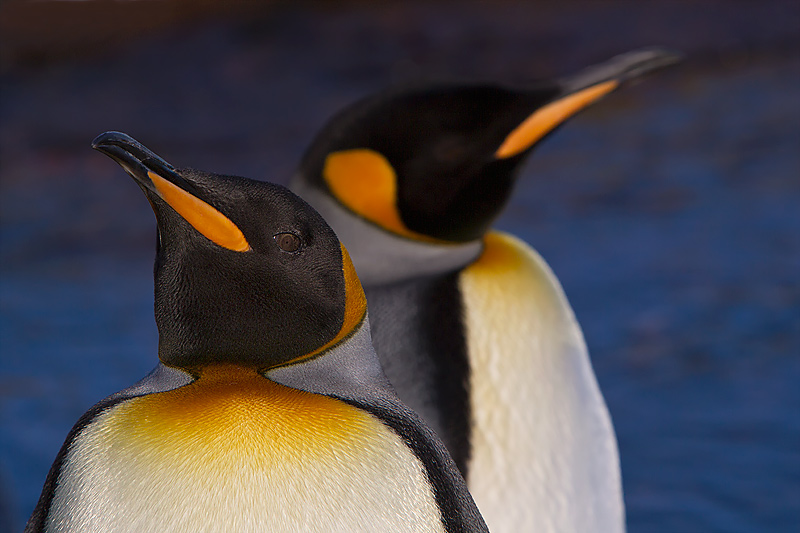
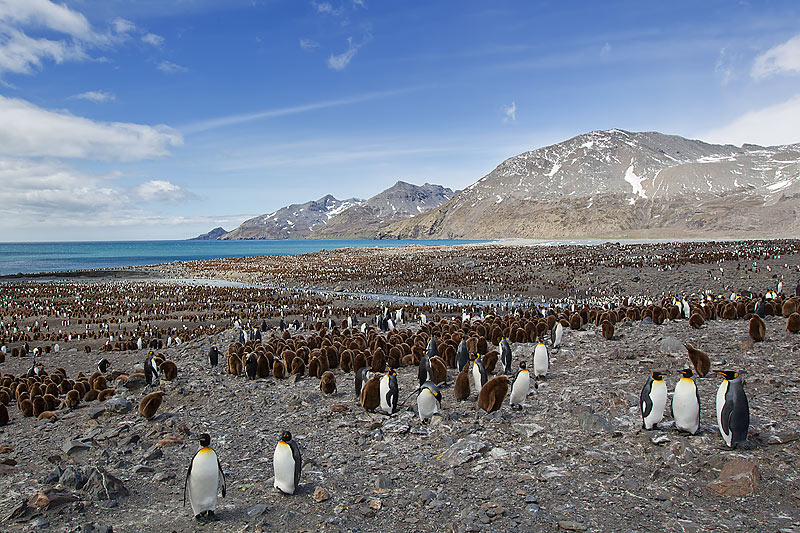
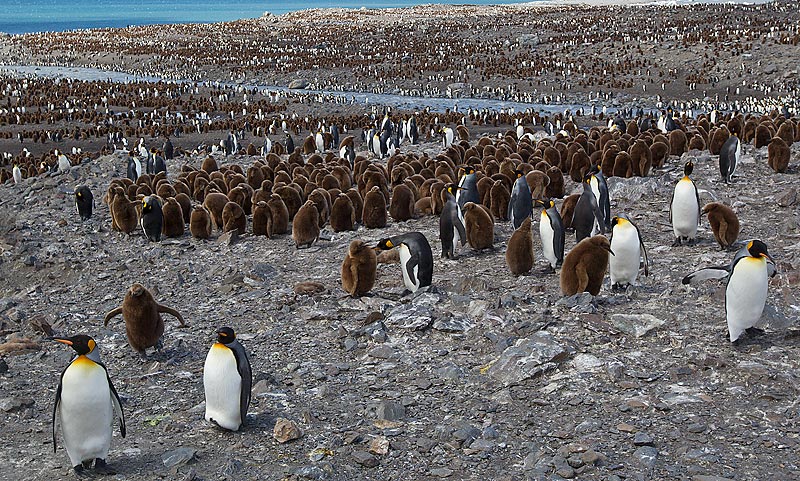
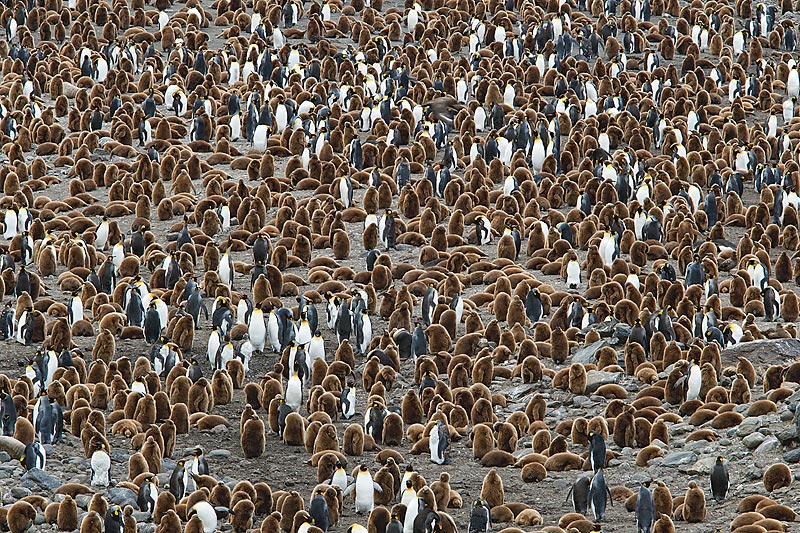
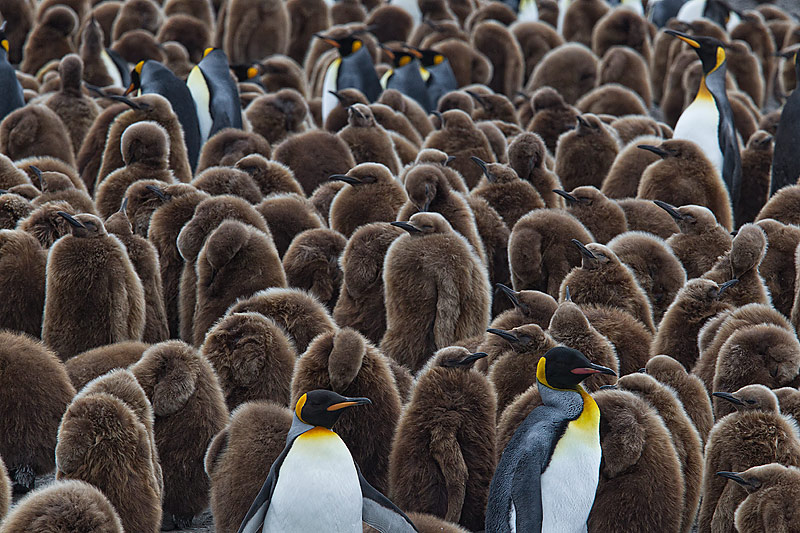
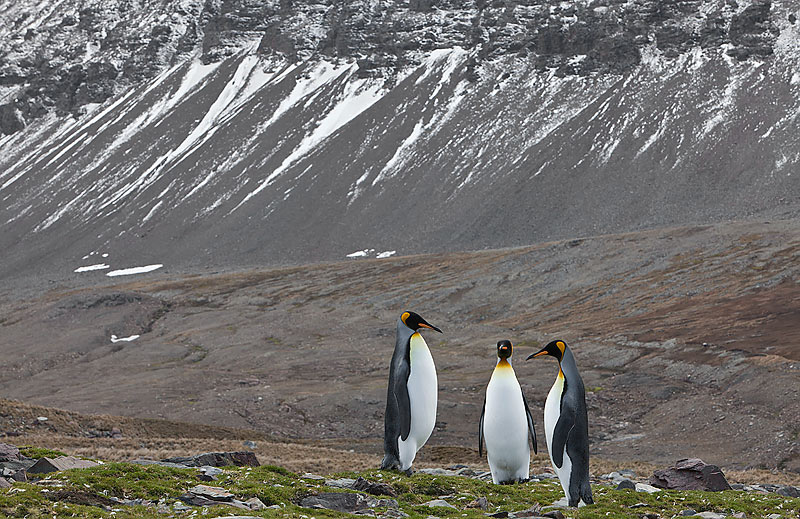
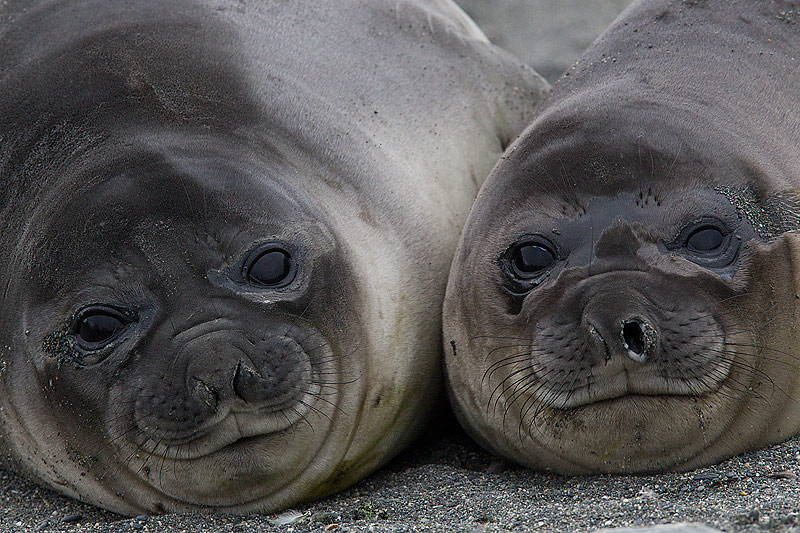
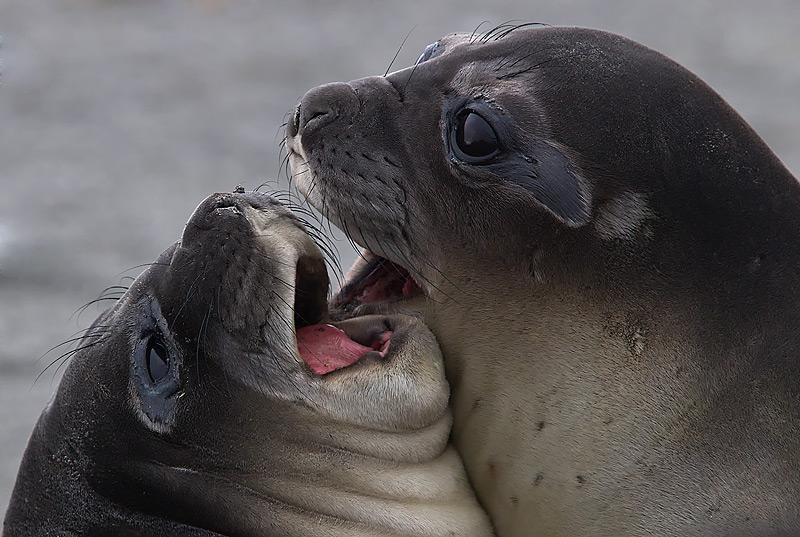
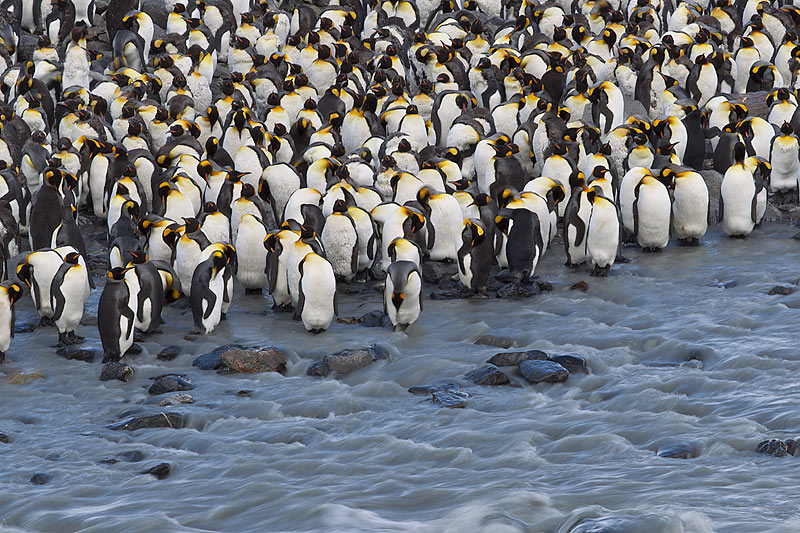
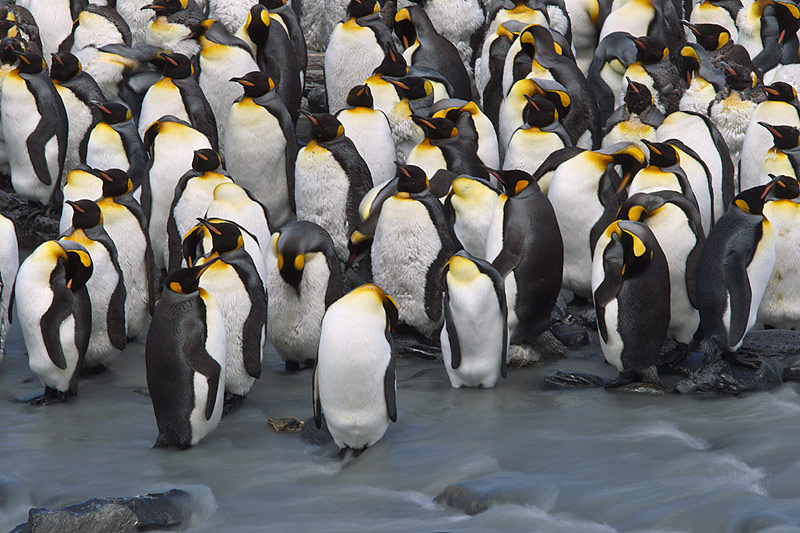
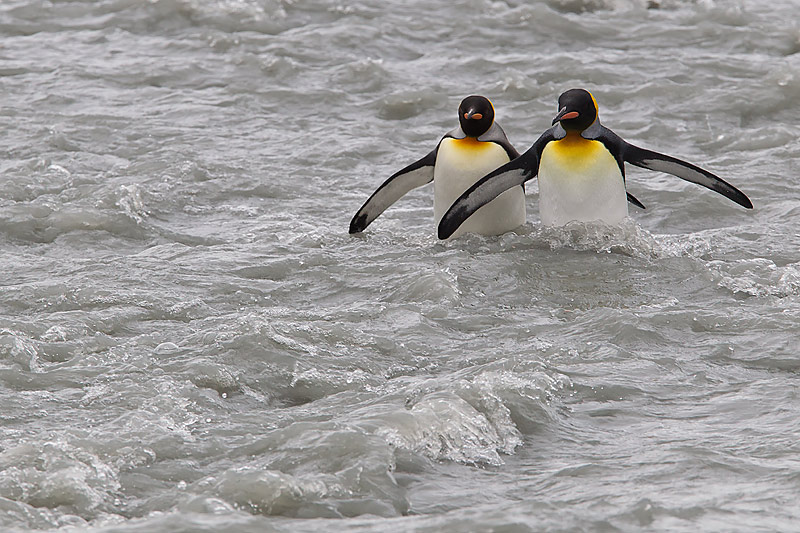
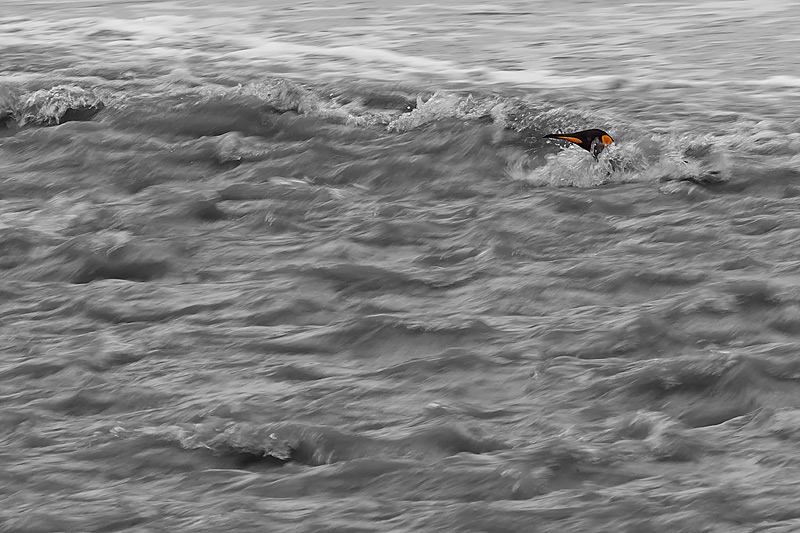
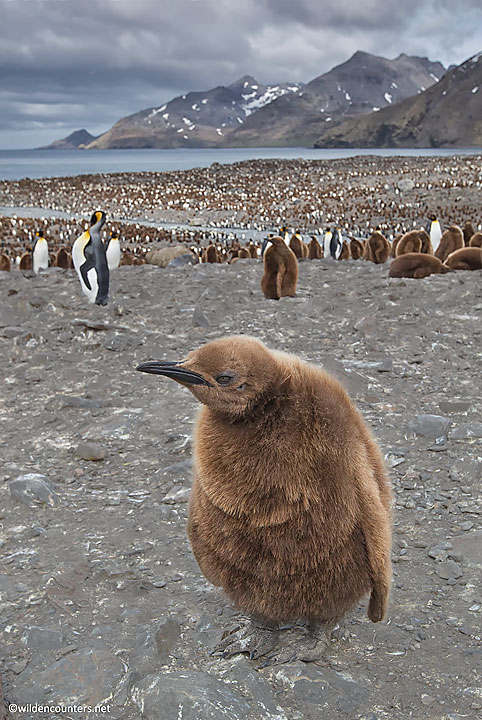
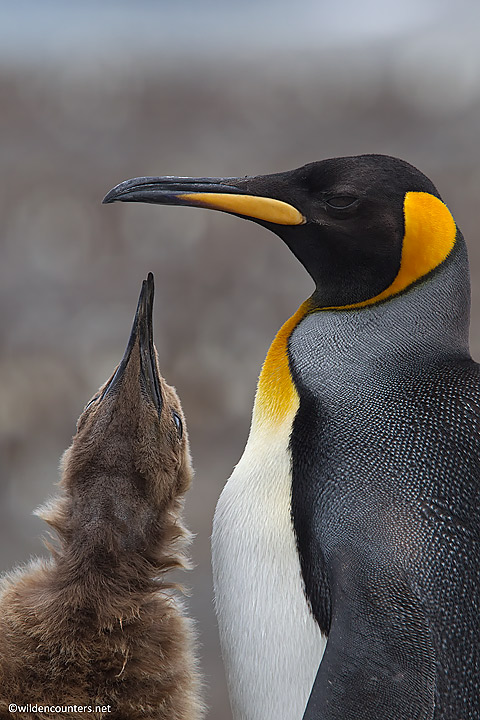
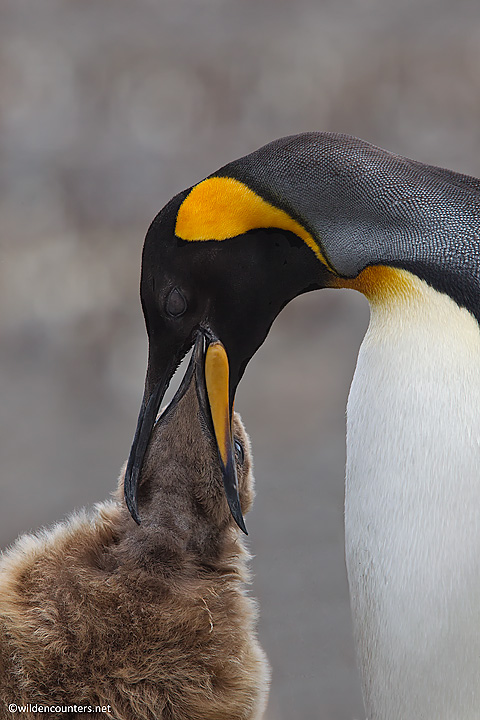
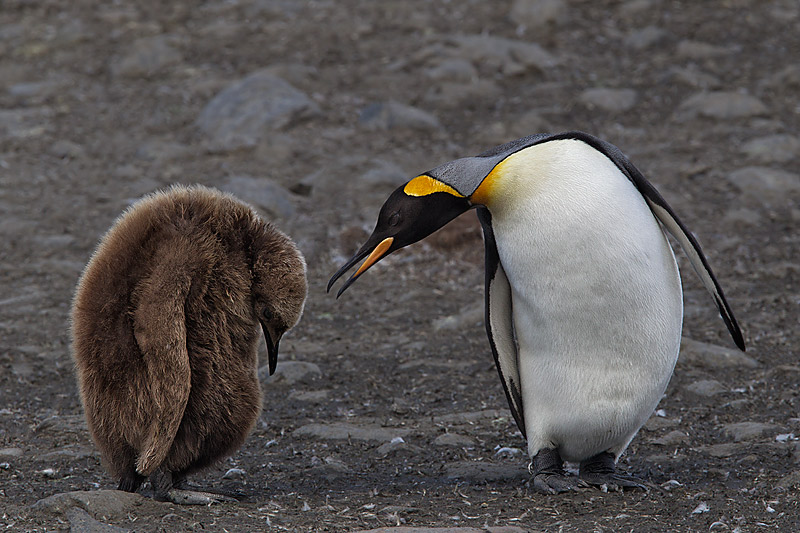
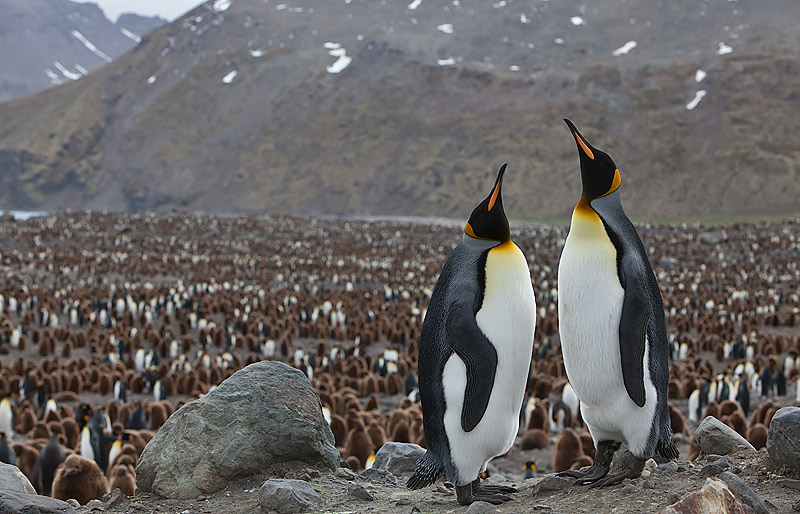
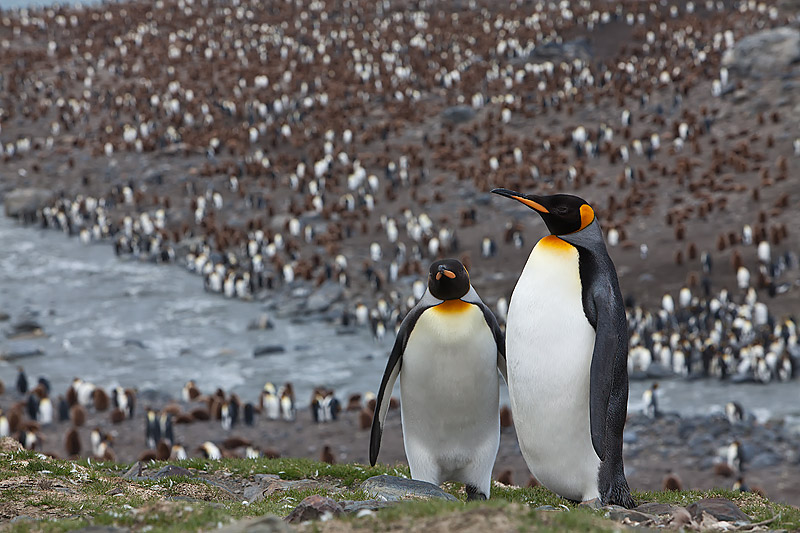
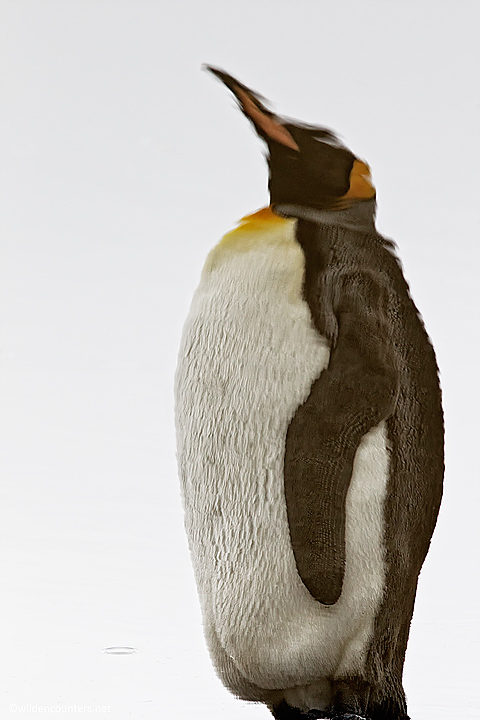
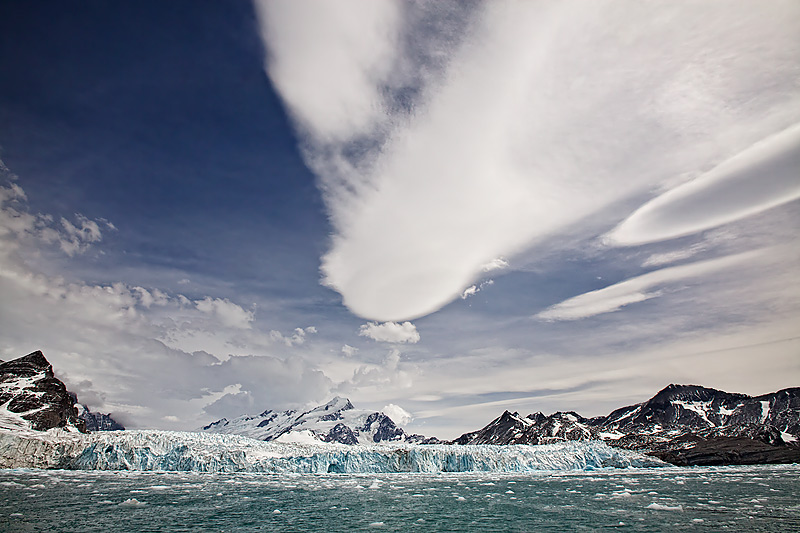
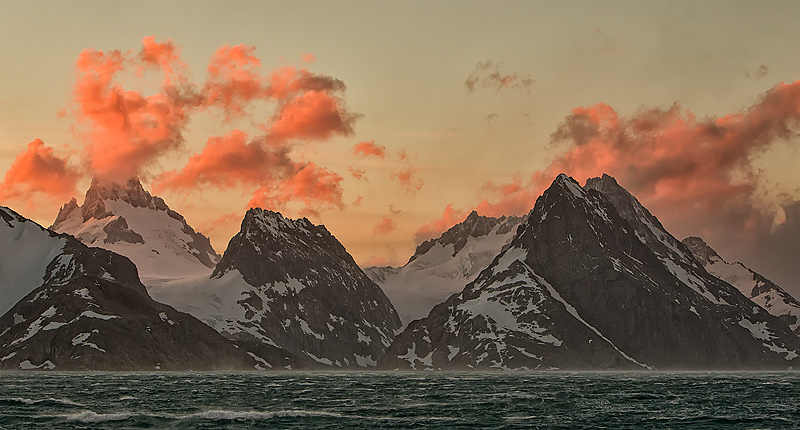
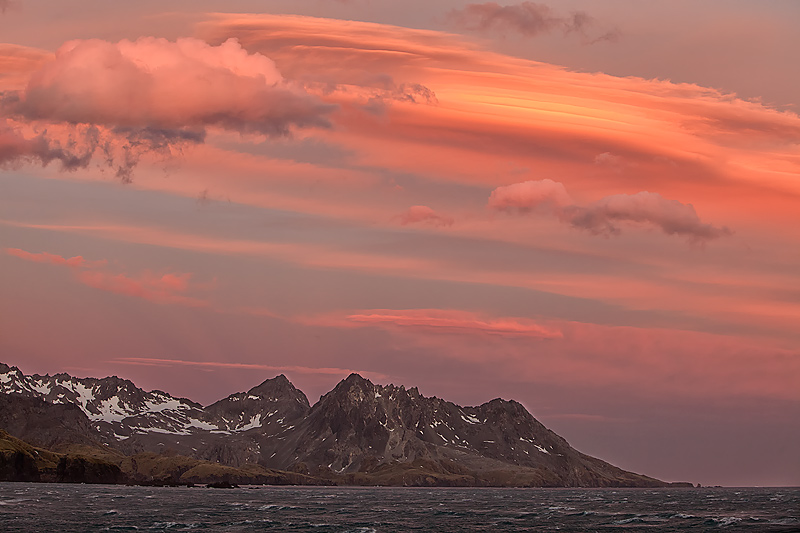
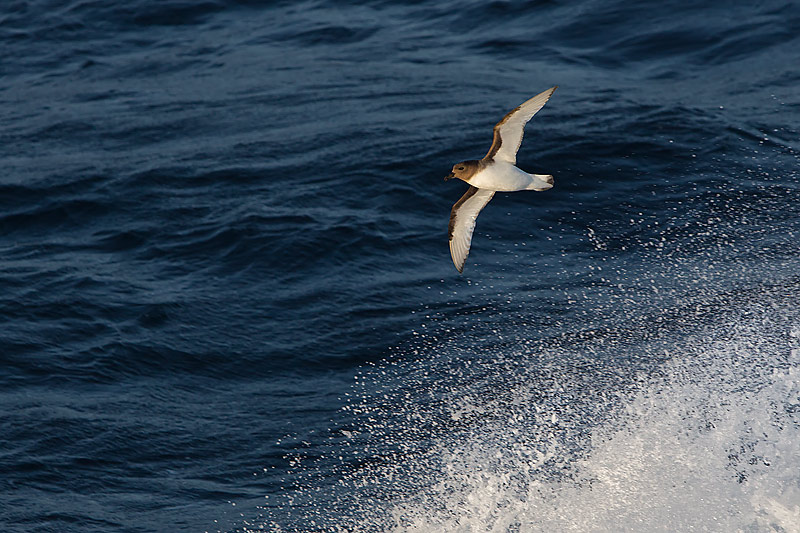
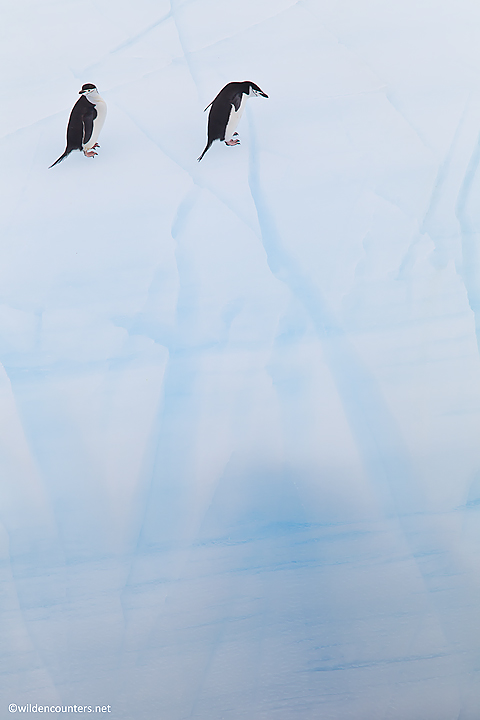
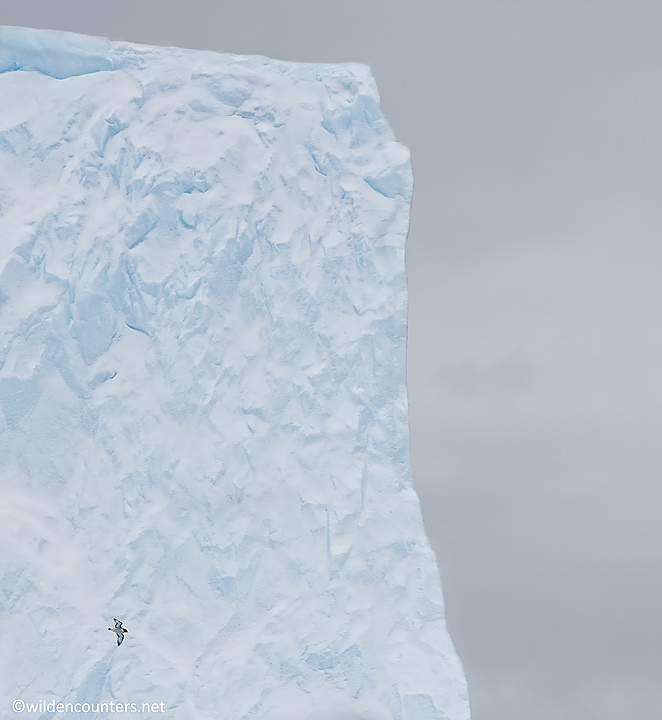
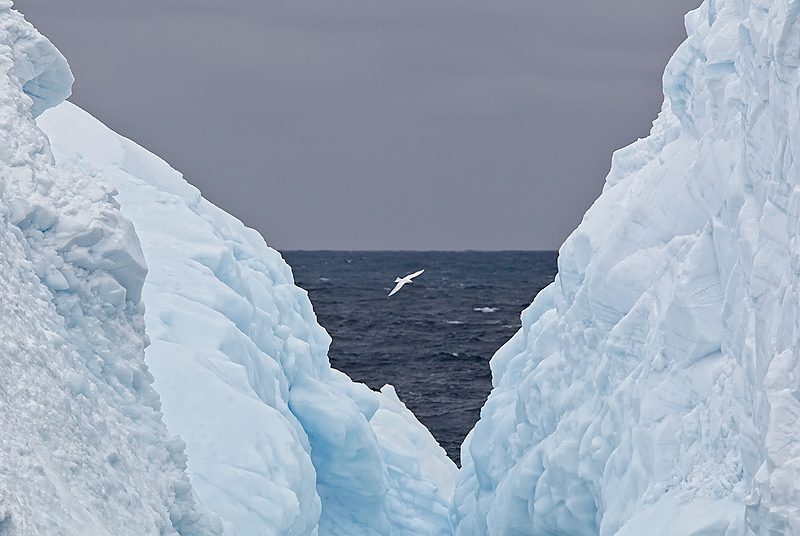
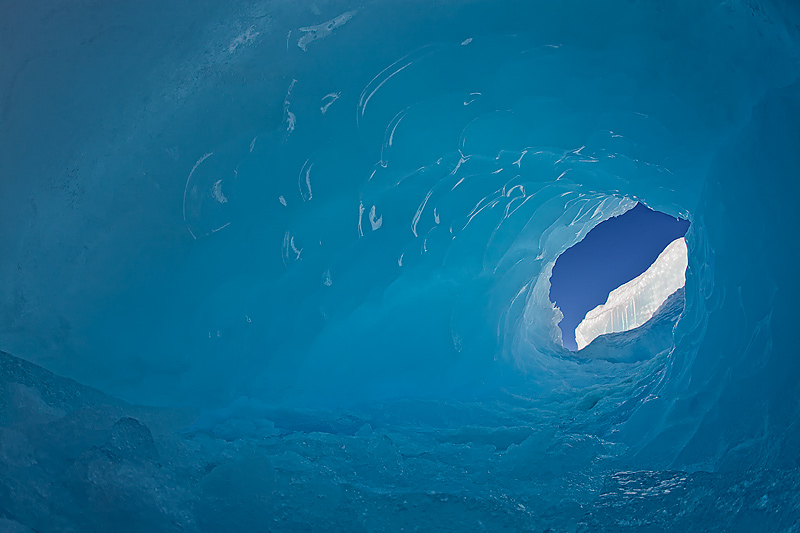
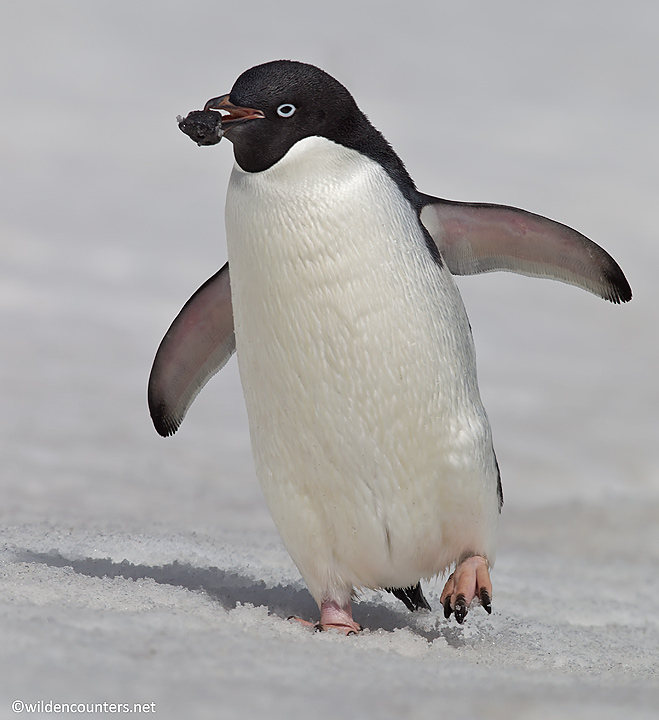
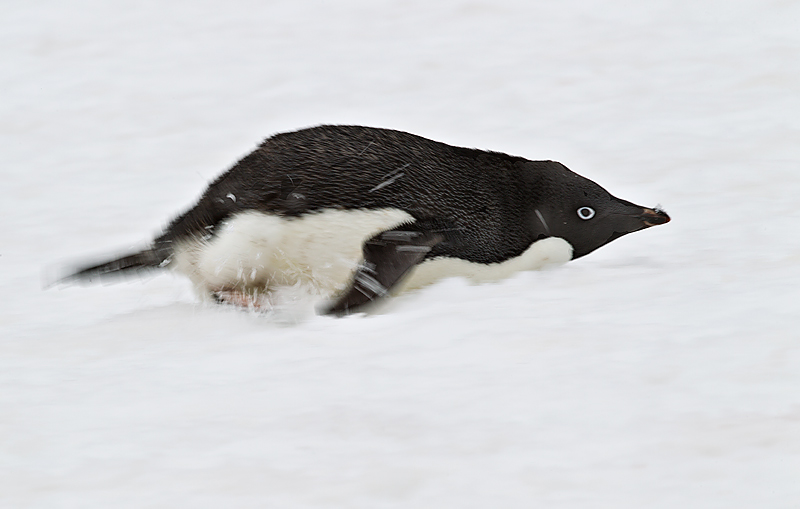
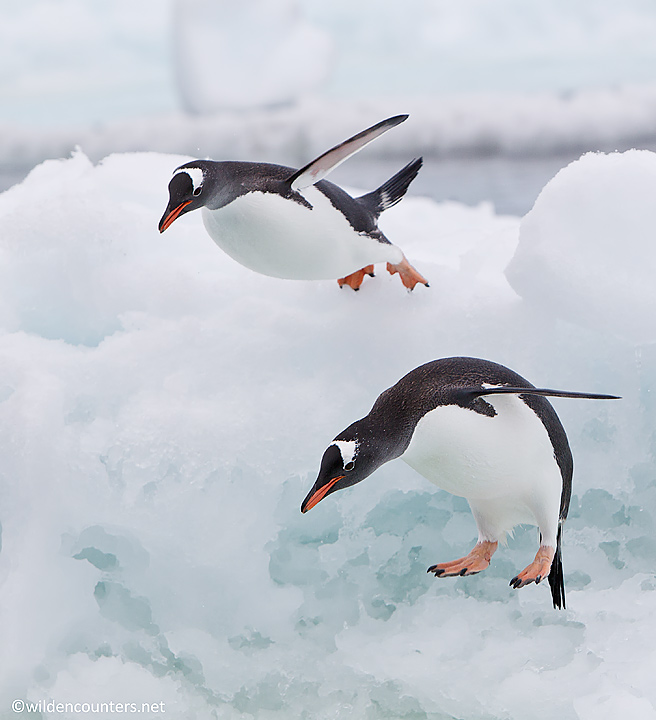
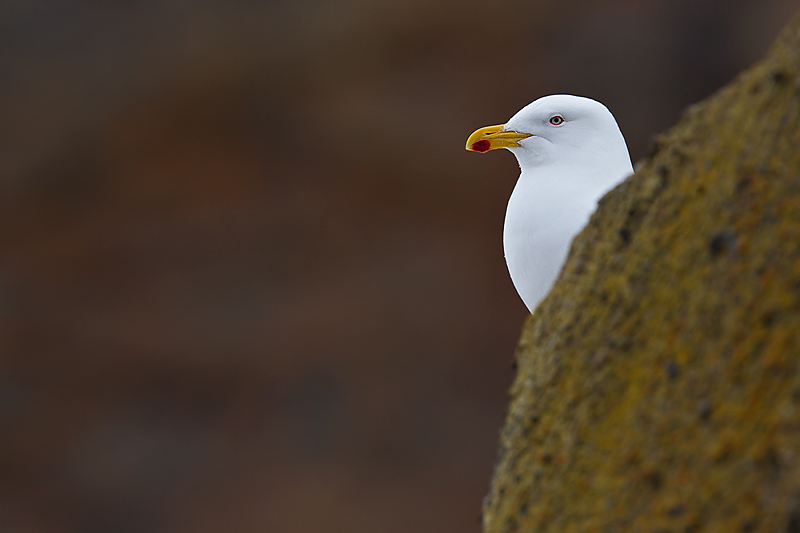
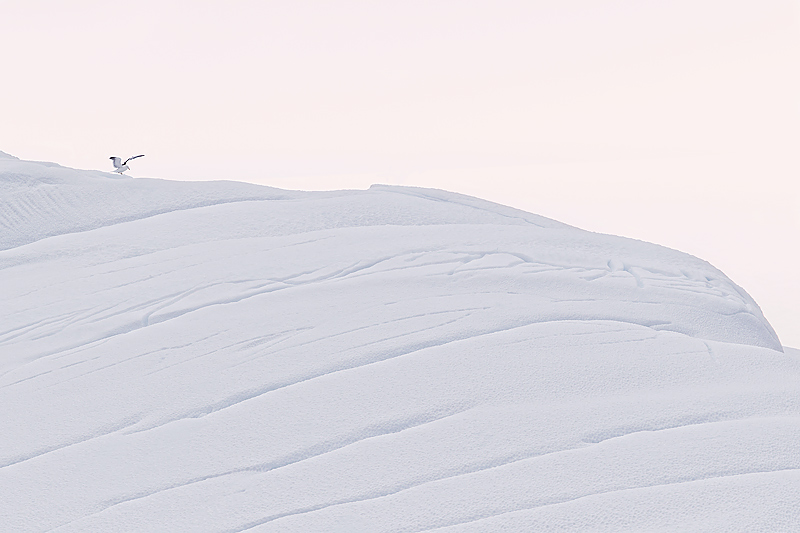
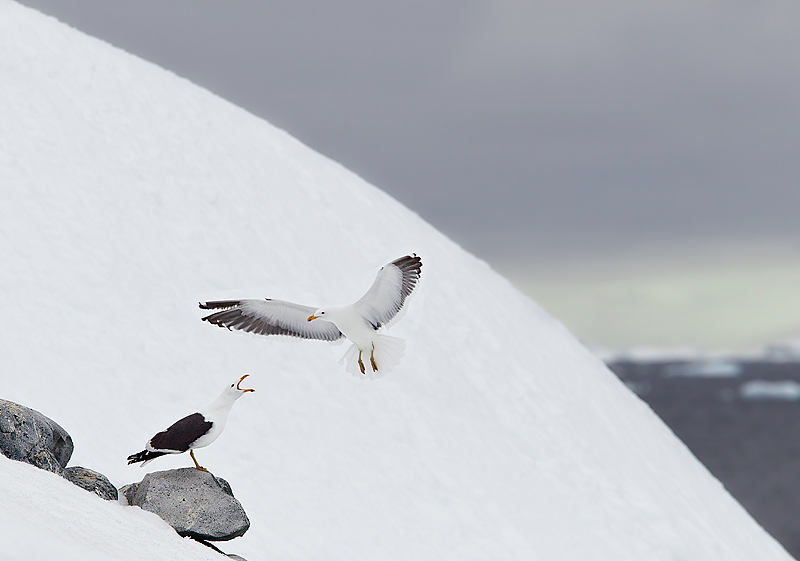
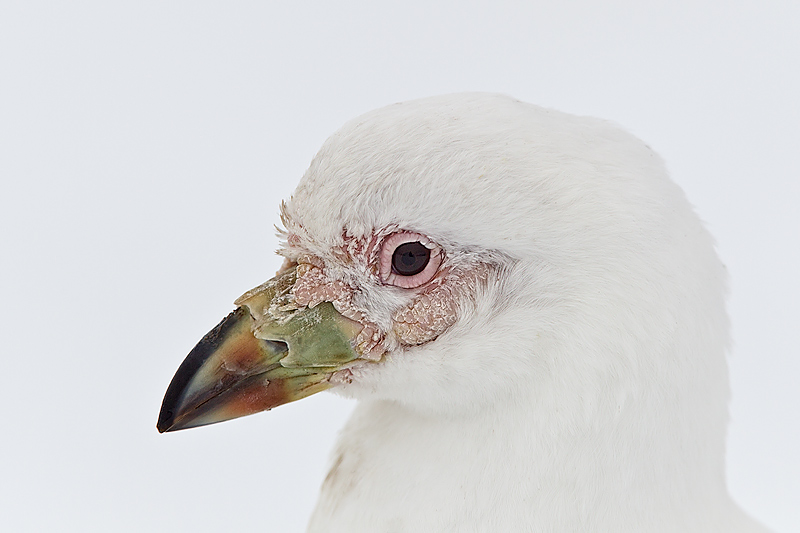
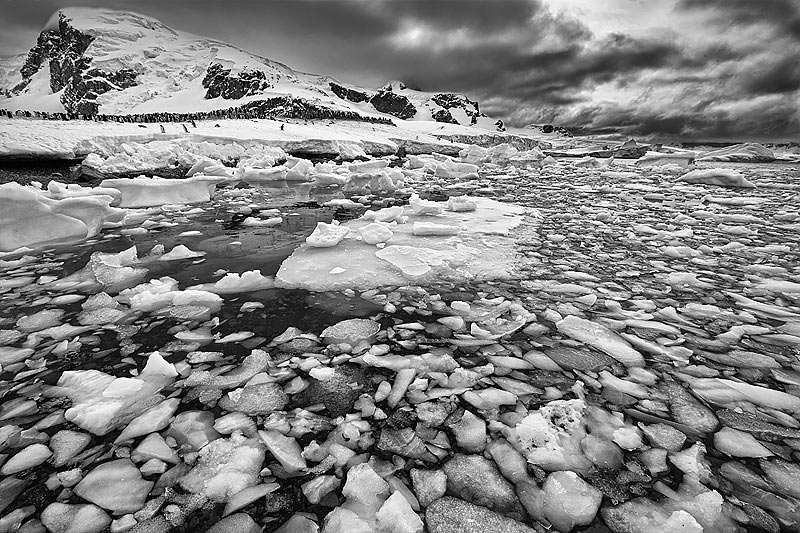
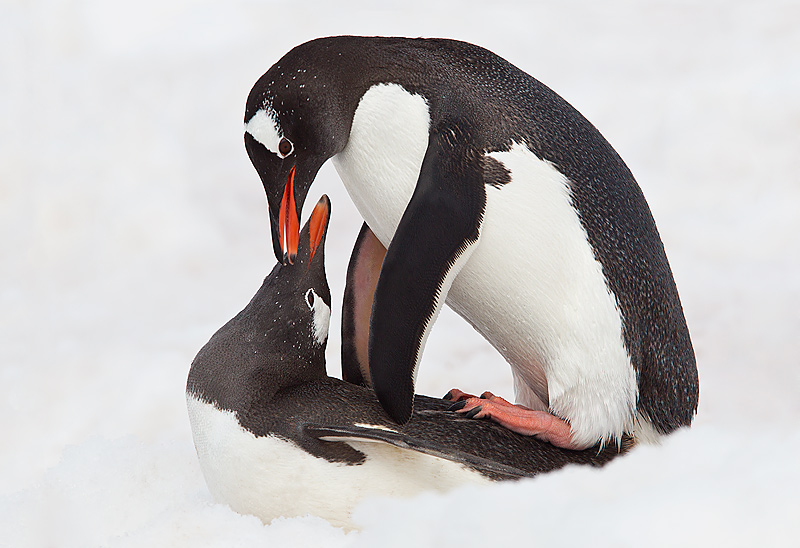
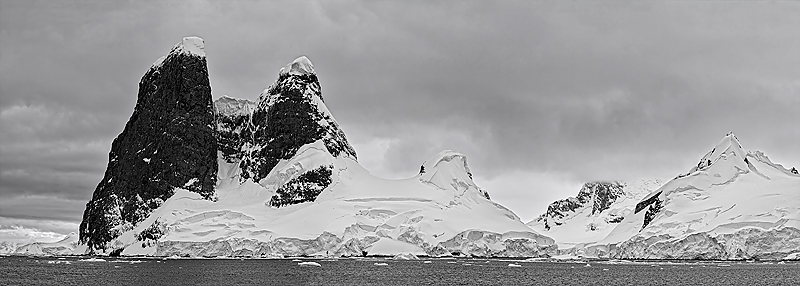
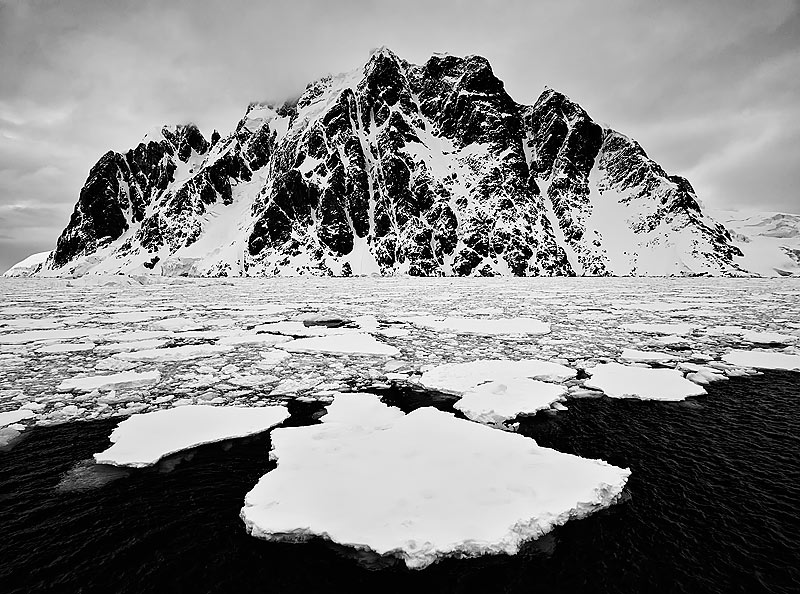
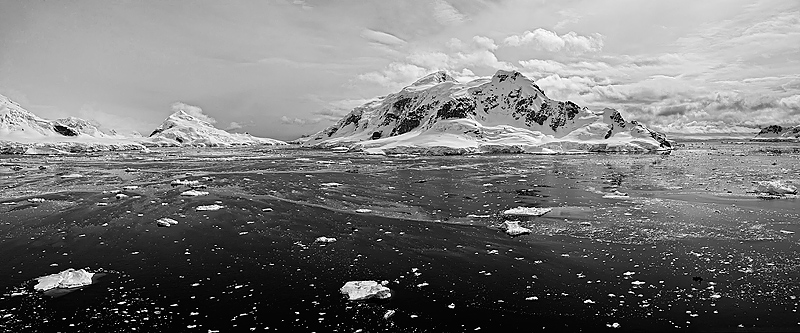
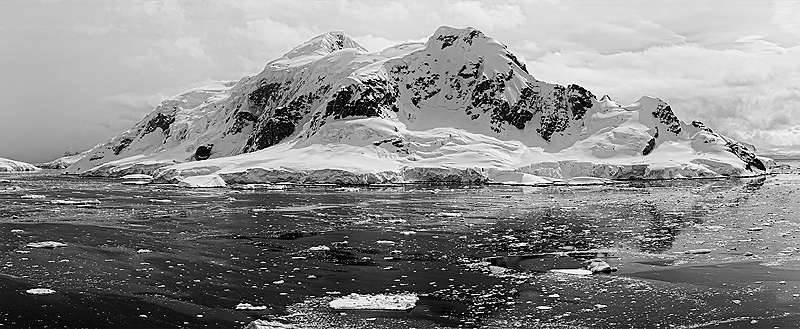
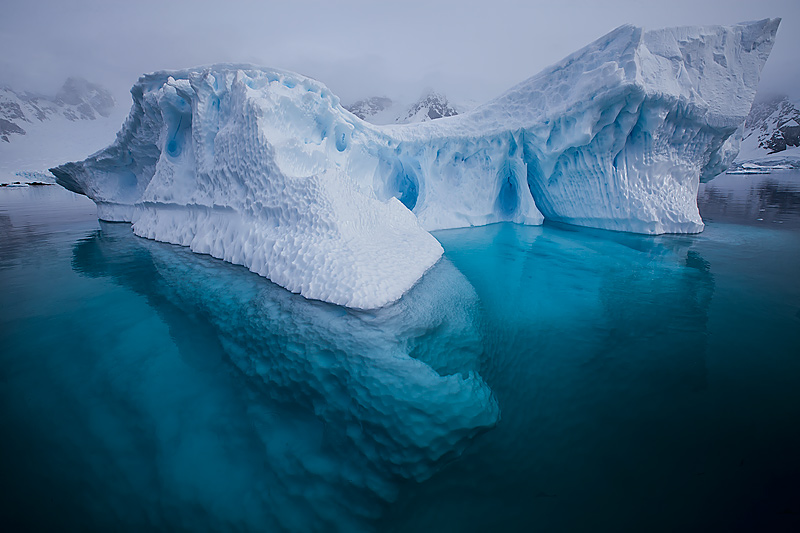
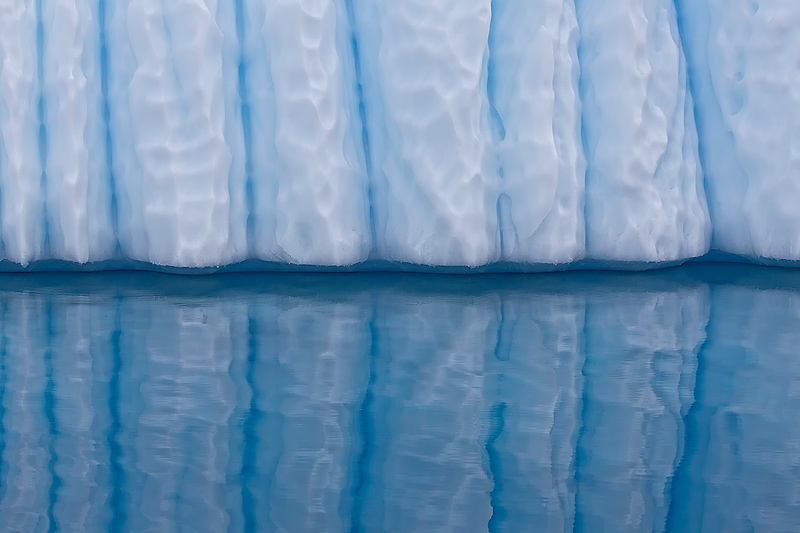
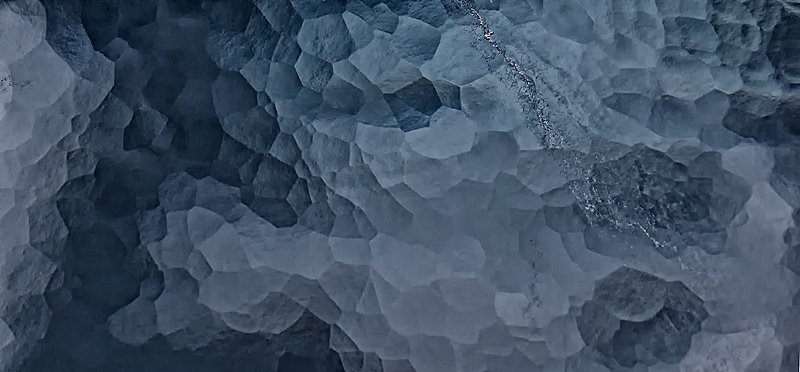
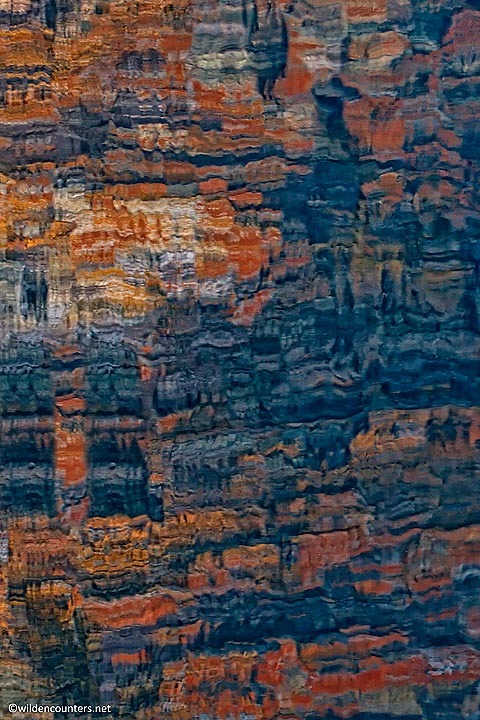
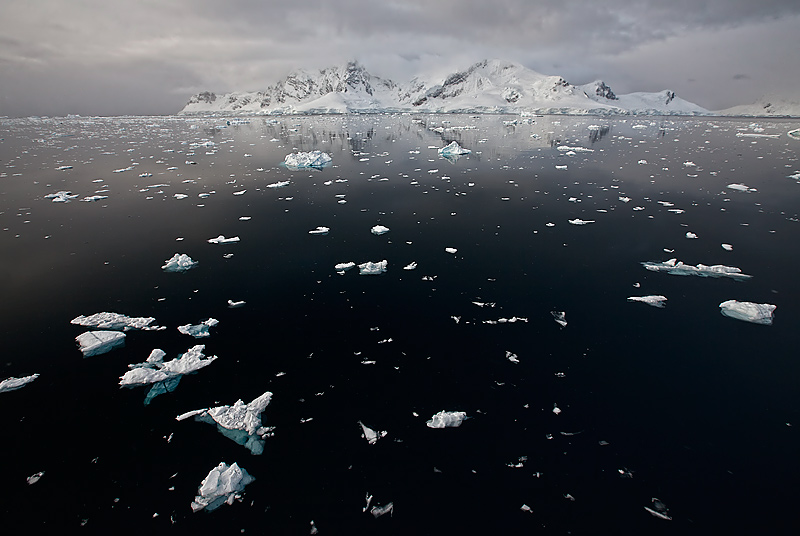
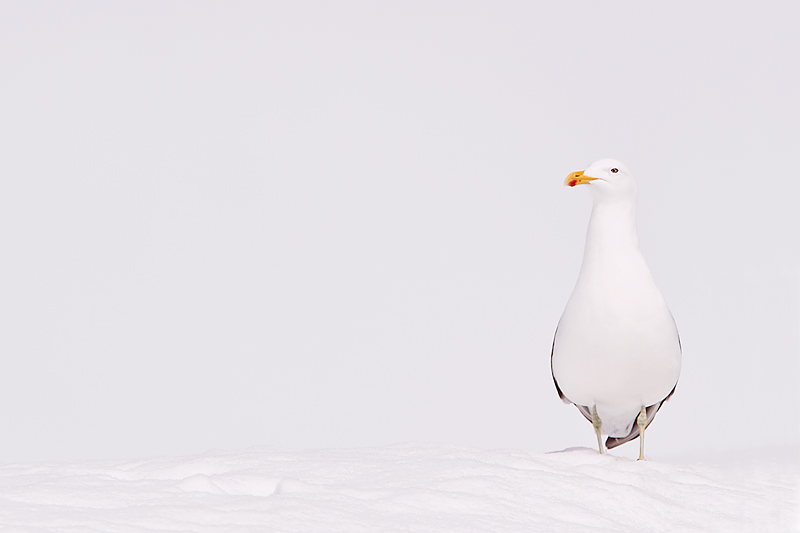
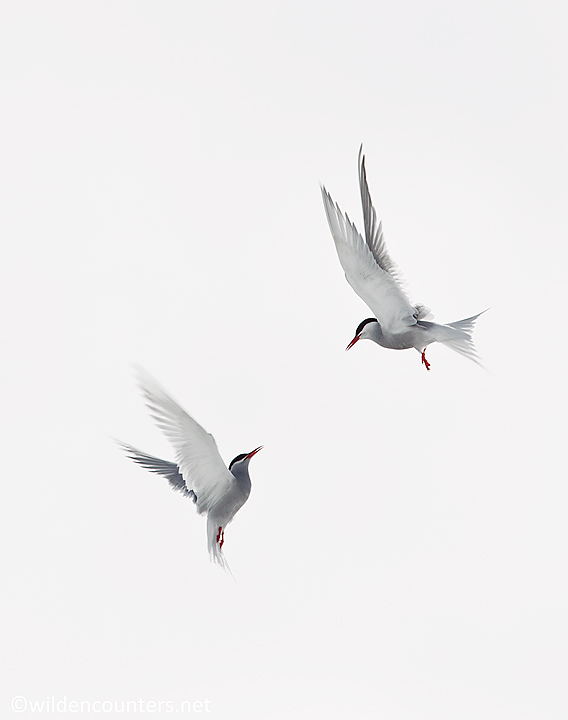
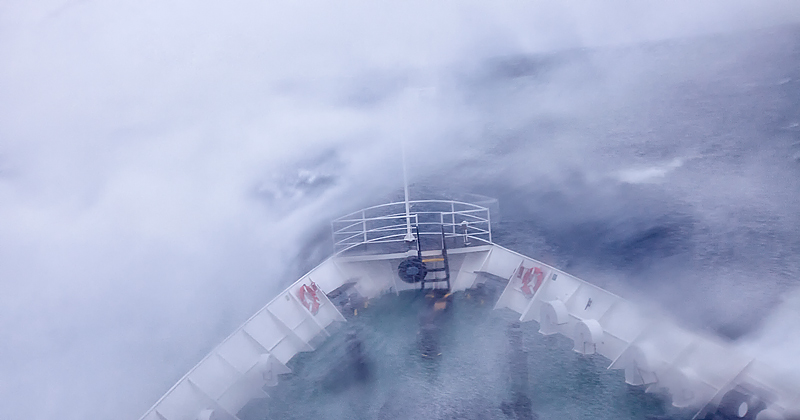
Maria
December 22, 2011
Really fantastic!
Maria
Ellizabeth Lodwick
December 22, 2011
Paul, Even more amazing pictures than usual from you. Just a beautifu portfolio, thanks for sharing
Elizabeth
Paul Mckenzie
December 23, 2011
Thanks Elizabeth. Keep in touch and have a wonderful Xmas. Paul
Lorelle
December 22, 2011
WOW
Paul Mckenzie
December 23, 2011
Thanks Lorelle for your appreciation. Happy holidays. Paul
Ellen B. Goff
December 22, 2011
Paul, I am blown away by your images! You have not only captured behavior and action, but have stunning landscapes as well. I agree with your comments in the last paragraph about Jaime Rojo. I would love to travel with the whole group again. I’ll look forward to your blog from your next trip.
Paul Mckenzie
December 23, 2011
Thanks Ellen. Yes, Jaime is very talented. Wish I was his age with his talent. Agree also that it was a great group. All the best, Paul
Richard Vernick
December 22, 2011
Paul,
Wonderful as usual. Really was a great trip.
Happy holidays.
Richie and Barbra.
Paul Mckenzie
December 23, 2011
Hi Ritchie – was great to see you and Barbra again. Thks so much for equipment loans on the trip and all the other “tech” advice. Am going out tomorrow to look for the Goflex hard drive. Keep in touch and have a great Xmas. Paul
Nick Easton
December 22, 2011
Paul,
Another stunning set of images. Thanks for sharing.
Nick Easton
Susan Knowler
December 22, 2011
This is great work, Paul. Thanks for sharing.
Best wishes, Susan & Tony Knowler
Paul Mckenzie
December 23, 2011
Hi Susan and Tony. Hope all is well your end. I will hopefully finalise some dates soon for the Masai Mara trips in August-October. Will keep you posted. Have a great Xmas. Paul
Paul Mckenzie
December 23, 2011
Hi Nick. Good to hear from you. What are you working on at the moment? How is the Africa production going? Keep me updated. Thanks, Paul
Ana Maria Ibarrola Alvarez
December 22, 2011
Hi Paul
I`m one of your new mexican`s friend ( the birth girl) Ana Mari.
I enjoyed a lot your report about our trip, when I was reading it, I`d remember all that big moments, specially in St Andrews the photo that you gave to all of us.
We already saw that photograph of the whale, that is important to you. Thanks for that beautiful story.
Great pictures !!! and african`s pictures too.
I`m sure I`m going to see you in some other trip.
HAPPY HOLIDAYS !!!!!
Paul Mckenzie
December 23, 2011
Hi Ana Marie, It was great meeting you and hope we can all meet again some day. Happy holidays, Paul
Gordon Lindsay
December 22, 2011
Hi Paul
Really terrific journey with some exciting images, thanks so much for sharing.
Gordon
Paul Mckenzie
December 23, 2011
Thx Gordon for all your support this year. Wishing you and your family a great Xmas. Best regards, Paul
Margie McNamara
December 22, 2011
memories………may be beautiful and yet…it’s too wonderful to remember!! Excellent job there Paul! Hmmmm….wonder if I shall ever get my act together!! maybe! In the new Year! Christmas in Aspen is too busy busy busy!!!
Paul Mckenzie
December 23, 2011
Hi Margie – r u free to babysit tomorrow night? ha ha. Still can’t get that video of you dancing at the bar night out of my head. Keep rockin’. Paul
Rodolfo Patron
December 23, 2011
Dear Paul! From sunny Mexico I salute you and congratulate you for such great pictures.
While viewing them, made me remind I was there, very close to you in many of your selected shots and remind me on a marvelous expedition, unique places, great moments, fantastic staff and new friends like you!
Happy Holidays!
Rodolfo
Paul Mckenzie
December 23, 2011
Hi Rodolfo – Great to hear from you. I suspect that many of us have similar images. Hope to see you again. Best regards, Paul
hank perry
December 23, 2011
Paul, extraordinary! We’ve been following your blog for awhile now. Congratulations on a fine journey with stunning imagery. My wife and i are traveling to SG&F next fall – any lens recommendations? sounds as if the winds made long lens work less possible. hank and karen
Paul Mckenzie
December 23, 2011
Hi Hank – I am also likely to be going to SG and F next Autumn. Maybe we are on the same trip. A 300mm f2.8 lens with and without TC’s is a good choice as your longest lens esp if used with a camera with a cropped sensor. Also a 70-200 and some sort of wide-angle zoom. Have a great Xmas. Paul
Ulla Spansdahl
December 23, 2011
Hi Paul
Really inspiring pictures and great text. It was a fantastic journey. I agree about St. Andrew’s Bay. I feel so lucky for being able to get ashore there. Also the Falkland Islands were a big positive surprise.
Thank you for sharing.
Ulla (the norwegian)
(PS: Got a picture of you with your head inside a growler at Paradise Bay. Guess it shows the difference between the professional walking out into the water examining and discovering the true beuty of ice, and the amateur taking a picture of how the professional does it).
Paul Mckenzie
December 23, 2011
Hi Ulla – your comments did come through. I just needed to click on them to approve them. Was great to meet you and hope we can meet again. Do you have snow where you are right now? Best regards, Paul
Lily Feduchy
December 23, 2011
WOOOWWW Paul!!! Thank you for sharing those images they are fantastic!!!!
Congratulations!!!
Happy holidays….
Lily (Latin….ja ja)
Paul Mckenzie
December 23, 2011
Hi Lilly, thx for your kind words. I had the wrong e-mail for you which i have now corrected. Have a great Xmas and hope to see you again soon. Paul
Bud Kovalchik
December 23, 2011
Hey Paul
Thanks for sharing your wonderful images. I hope my photos are half as good (hopefully some will be comparable and sell-able). However, my computer broke down as I loaded my first images and it will be several more weeks before I know if it is fixable. So far two computer repair shops (and ME) have never seen anything like it. All the hardware is good and there are no infections but MICROSOFT shuts me down when I do anything on Photoshop, WORD, EXCELL, ACCESS — anything.I think some script got into it and is/are acting like virus. I’ll likely have to buy a new PC and upgrade lots of software which is difficult (lack of $) after the expense of the Antarctic trip. I’m getting a list of northwest USA art shows together and applying to those that are open in the meantime. Look for a shorter Ultimate Antarctic story on my web site someday.
Bud Kovalchik
Paul Mckenzie
December 23, 2011
Hi Bud – bloody computers and I really should switch to Mac. When I was writing the blog via WordPress, the programme must have crashed 10x! Anyway, hope you get things fixed and I will look out for your blog. Best, Paul
Joe McDonald
December 23, 2011
Hi Paul,
Pleasure sharing that trip with you, but it is McDonald, not Mac! Anyway, spectacular images and your portfolio matches the others you showed me, which were wonderful. Keep up the great work.
Joe
Paul Mckenzie
December 23, 2011
Duhh – two of your books are sitting across the shelf from where i sit and i still can’t spell your name! It was great meeting you and Mary Ann (now I can’t remember if that’s with or without an E). Definitely hope we cross paths again. Have a great Xmas and enjoy your travels next year.
Joe McDonald
December 23, 2011
Great shots, I don’t know if you received my first set of comments! Darn computers!
Joe
Yan Verschueren
December 23, 2011
Hi Paul,
Amazing pictures. Perfect done. It’s a privilege that you chare us all these nature wonders. The pictures are so artistic, so a live, so close, that I get the feeling that I be there at the same spot and have a great encounter and join the moment!
Do you have all ready plans for 2012
Thanks
Yan
Paul Mckenzie
December 23, 2011
Hi Yan. Thx again for your support and hope all is good at WWF in Belgium. I have some plans for 2012: Hokkaido again in February with Makoto san; Midway Atoll in April; French Polynesia in July; Masai Mara probably twice in Aug/Sept/Oct and then Falklands and South Georgia in Oct/Nov. Will try and fit some other trips in too. Still have to get to the Congo but the visa restrictions are quite restrictive now as Beijing is no longer issuing tourist visas – DRC now requires that visas be issued in your country of nationality (for me, Ireland). Some friends of mine had theirs arranged in Uganda but got turned back at the border. Anyway will keep you posted. I will be running some trips to the Mara during Aug-Oct and will keep you posted.
Mark Schaaf
December 23, 2011
We enjoyed these so very much. Gail told us that this was her most adventuresome and dramatic voyage ever. Now I see why. Your photography is amazing. Thank you so much for sharing.
Mark & Carla Schaaf
Paul Mckenzie
December 23, 2011
Thanks Mark. Am glad Gail enjoyed the trip. Take care and have a great Xmas.
paulina rodriguez
December 23, 2011
Paul, this is wonderful, your images are amazing. Even more, you transported me back to marvelous places.
Thanks a lot for sharing,
Paulina
Paul Mckenzie
December 23, 2011
Thanks Paulina. It really was a fantastic trip. Hope to see you again soon.
Vincent Ho
December 23, 2011
Paul –
Thank you for sharing this — fantastic images! Bravo! Happy holidays to you and your family!
Vincent
Paul Mckenzie
December 23, 2011
Thanks Vincent. It was great meeting you. Have a wonderful holiday season.
Simon Harris
December 23, 2011
Paul, your eye for detail is matched only by your aesthetic vision.
Quietly blowing us out of the water, mate – well done!
Simon
otto plantema
December 23, 2011
Again a fantastic portfolio, Paul,
my guess is that you made the trip with the dutch Plancius?
Regards, Otto
Paul Mckenzie
December 24, 2011
Hi Otto. In fact it was a Jo Van Os trip. Really fantastic and Joe and the other leaders did a terrific job. Stay in touch. Paul
Jakes Jordaan
December 23, 2011
Hi Paul
Man you’ve got the eye! Your images are beautiful. Thank you for letting me re-live the great Antarctic experience . Well done!
Hope our paths meet again.
Happy holidays.
Jakes.( South africa)
Paul Mckenzie
December 24, 2011
Hi Jakes. It was really great meeting you and Byron on the trip. Hope you are having good weather in S.Africa. Look forward to crossing paths with you again. Paul
Karen Andrews
December 24, 2011
A superb text and exquisite images, the combination of which successfully captured the essence of our adventure! Many thanks for sharing!
your fellow travelers Karen and Ray
Paul Mckenzie
December 24, 2011
Hi Karen & Ray. Thx for your kind words. Happy holidays.
Tom and Sue Fuchs
December 24, 2011
Paul – Fantastic images. How did you get them up so fast? You have have really motivated us to get going with our shots. Hard to believe that its almost three weeks since returning. We look at your photos and we are back aboard the Ushuaia responding to “Good Morning Expeditioners” . Thank you so much for sharing.
Tom and Sue
Paul Mckenzie
December 24, 2011
Hi Tom and Sue. Glad that I could help you relive those memories. I was able to process a lot of images on board the ship during our passages which helped with the speed. Enjoy the holidays.
cindy walpole
December 24, 2011
Wonderful images, Paul. Having been there twice, I really appreciate the work that went into this. You have certainly captured it! Congratulations.
Take a look at our new web site. After we met at Midway, we started photographing the hummingbirds of Costa Rica.
Regards, Cindy
http://www.focusfrog.com
Paul Mckenzie
December 24, 2011
Thanks Cindy. Appreciate your support. Will check out your site and the hummingbirds. Happy holidays.
Jaime Migoya
December 24, 2011
Hi Paul
Thank you for sharing your outstanding images and text. They bring back fond memories of a great trip.
This morning Regina and I went photographing the Monarch butterfly sanctuary. We had to go all the way to South Georgia to become aware how lucky we to have one of the world’s great migrations so close to home.
It was great listening to your stories while having dinner at the “latin quarter”. Rodolfo gave us as a Christmas present the book with the whale image that you gave your wife. We had fun guessing which one it was.
We hope to see you again sometime in the future. Africa maybe?
Have a Merry Christmass. Regina and Jaime Migoya
Ted Cheeseman
December 24, 2011
Hi Paul — a friend just pointed me to your images from the recent voyage — fantastic work — Sure looking forward to having you onboard in Oct/Nov back to South Georgia! ~ Ted
Paul Mckenzie
December 25, 2011
Am really looking forward to the trip as it will involve even more time in the Falklands and South Georgia. See you soon. Paul
jattinn kochhar
December 24, 2011
MAGNIFICENT! is all i can say and share…
Paul Mckenzie
December 25, 2011
Hi Jattinn – got your card with the family photo. Thanks. Have a great Xmas. Hope to see you in 2012. Best regards to you and your family, Paul & Paveena.
Steve Sage
December 25, 2011
Paul,
Thanks for sharing this collection of inspired, insightful and technically masterful images. It was great to review the awesome natural beauty we shared on this adventure. The text is also a wonderful summary of the trip. I love your images!
Happy Holidays!
Martina
January 9, 2012
Thank you so much for these great pictures! WOW!!
Greetings from Germany
Vera Jameson
January 9, 2012
Absolutely the most spectacular, beautiful picturesVer, the detail, exquisite!
Paul Mckenzie
January 9, 2012
Thx so much for you’re extremely generous praise Vera. Best regards, Paul
Ursula in Delta, Canada
January 9, 2012
Paul,
Happy New Year and Photo Trips in 2012!
I got to your photos through Artie’s blog – and you took me right back to my trip a couple years back – thanks so much for sharing your wonderful photos. I went with Van Os, and Joe McD was one of the photographers and of course, we were on the Ushaia, too – but our crossings were rather more vigorous than yours!
Gain – thanks for stirring my memories!
Paul Mckenzie
January 9, 2012
You’re Welcome Ursula – hope you can get down there again some day. Paul
lesa corrine
January 9, 2012
Amazing,,,,Stunning…..
Les Check
January 10, 2012
Hi, Paul,
They’re so good I was green (perhaps it should have been “white”) with envy. Great, great images!
Paul Mckenzie
January 11, 2012
Thx Les for your kind words. Best regards, Paul
Randy Dutka
January 11, 2012
What ship were you on? We did almost the same trip on the Silversea Prince Albert II (at that time). It’s a truly wonderful experience and every time I see photos like these (although not usually as good as these), it brings back the whole experience. Thank God for Zodiacs!
Paul Mckenzie
January 11, 2012
Hi Randy, I was on the Ushuaia. Great ship, great crew and great, great fellow travellers. Best regards, Paul
Joanna Patterson
January 11, 2012
Awesome shots along with very informative and beautifully written commentary Paul. I brought neither the equipment nor the expertise that you brought to this exposition. Even so I did come home with a lot of satisfying images.
If you ever do a workshop in the US I would love to attend. Sorry I can’t join you in Africa this year. Perhaps another time.
In any case I am delighted to have been added to your email list and look forward to your next soul satisfying visual feast.
Happy New Year to you and your family.
Joanna
Abilash G
December 31, 2012
Amazing is your content and the photographs … WOW !!!!……
blortz
September 23, 2014
beautiful!
Ursula
December 7, 2014
I took the same trip in Nov 2009 – same photos )almost), except yours are much better! but that’s ok – I enjoyed the trip as much as you did! I wouldn’t mind doing it again, but there is the matter of lack of money! Really enjoyed re-living my trip through your photographs!